The Story of Bonhill Parish Pipe Band 1931 - 1979
Last Updated: Wednesday 11th November 2009
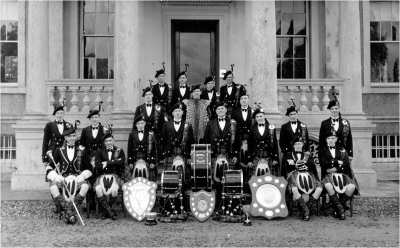
Bonhill Pipe Band (Circa 1948) taken in front of Strathleven House. (Click to Enlarge)
Acknowledgements
As is the way of things, there are not many bandsmen or committee members of Bonhill Parish Pipe Band (“BPPB”) still in the Vale to-day to consult on the Band’s history, but many family members of bandsmen and committee members are still here, and a number have contributed time, reminiscences, photos and other materials to what follows. The main regret is that it although there is video of the Band parading in various places in Colin Liddell’s Lovely Valley films, it has so far proved impossible to find any recordings of the Band playing.
In no particular order, thanks are due to the following people for their help and contributions:
- Bruce Rennie, piper and baker in Renton who was a member of the Band from the 1940’s onwards
- Dougie Wallace from Balloch, who was a side drummer in the Band from 1947 onwards, and who has provided many photos and reminiscences.
- Morag Lawrie (nee Jackson), whose father, Pipe Major Jimmy Jackson, was a founder piper of the Band, and Pipe Major of the Cowal-winning Band. Morag’s husband Gordon Lawrie, though he never played in BPPB, has maintained the Pipe Band tradition in the Vale, playing with and being Pipe Major of a number of Bands, including Dumbarton & District Pipe Band. Gordon is on the executive of the Royal Scottish Pipe Band Association and is a judge at Pipe Band competitions.
- Mary Ainsley (nee Smith) whose father, Neil, was Treasurer and then Secretary of the Band from its early days until his untimely death in 1958, and whose mother took on the job of Secretary and stayed with the Band until it was finally stood down in 1979.
- Irene Miller, widow of Drum Sergeant Alex Miller, who was the first person to win the Pipe Band Championship and individual Drumming Championship at the same Cowal.Championship.
- Campbell Smith, son of piper Hugh Smith, who was a founder piper of the Band and Cowal winner, and cousin of Drum Sergeant Alex Miller.
- Mrs Martha Kelso, widow of Drum Major Jimmy Kelso.
Any mistakes are the author’s.
Introduction
First, a word about the name. It is often referred to as “Bonhill Pipe Band” suggesting that it was perhaps based in Bonhill. The Band’s actual name from the very outset was “Bonhill Parish Pipe Band”, which was a conscious decision on the part of the founders to encompass the whole of the Parish of Bonhill – Renton had its own Pipe Band at the time. Over the years, its members came from all over the Vale, including Renton, as well as Dumbarton, Old Kilpatrick, Clydebank and Glasgow, reflecting the Band’s wide appeal.
Secondly, at the end of the history of the Band, there is a list of the names of the people who could be identified in documents such as minute books and newspaper cuttings as being involved with the Band as Bandsmen, Ladies Committee members or office-bearers. It is clear that there are gaps in the list: there are no doubt a number of members for whom no documentary evidence has been found and they don’t appear at all, many names are incomplete, with first names only being represented by an initial or in some cases not even an initial, while for others we don’t know whether they were a piper or a drummer. We ask for your help in filling these gaps.
Until quite recently the Vale had a great musical tradition dating back to the foundation of the Bonhill Instrumental Band in 1817. There were brass bands, silver bands, even flute bands and last on the scene, pipe bands. With the exception of Dumbarton & District Pipe Band, all have disappeared now. Few made such an impression on the Vale and none won so many national accolades as Bonhill Parish Pipe Band. In its 20-odd years of top-class playing, the Band was taken to heart by the people of the Vale in a way which was almost unique at the time. It did this not just by gathering a group of very competent pipers, drummers and administrators, and then practicing hard, but also by getting out and about in the community at large. It always tried to accommodate requests for it to parade in support of other organisations from the British Legion to Sunday School trips, and by taking the initiative itself and playing in the different housing estates of the Vale for people’s entertainment. It well deserved the affection and high esteem in which it was held.
And, of course, it was a highly competent band, with quality and enthusiastic bandsmen and a back-up team of fund-raisers and supporters which was the envy of most other bands in Scotland. Starting the Band in 1931 at the height of the Depression was a brave decision, not least because Pipe Bands are expensive to equip and the Vale was an unemployment black spot. However, through incessant hard work at fund-raising, not least by lady supporters, the money was found and the Band performed. It made its first competitive appearance within 2 years of its foundation, in the Mar Pipe Band Competition at Alloa in May 1933, winning a very creditable 3rd place in Grade 2, and thereafter steadily climbed the Pipe Band rankings in the 1930’s. Among many fine performances in the 1930’s, the highlight was probably winning the British Open Championship in 1938 and Bonhill Parish finished the decade as a prominent Grade 1 Band.
Inevitably, with almost all of its members being young men, the Band’s momentum was interrupted by WW2 when most bandsmen were called up into the armed forces. It was the same with every other band, of course. The Band essentially went into hibernation for the duration, although a core of bandsmen kept the Band ticking over. With most of its members home from the forces by 1946, the Band was soon back on its winning ways. The peak of its success was, of course, winning the Cowal Championship in 1952, which was the de facto World Championship at the time (although an official World Championship had already started.) The whole Vale seemed to join in the celebrations of that event, and the icing on the cake came the following year when the Band paraded at Hampden Park as the Vale of Leven FC won the Scottish Junior Cup. Happy days indeed.
However, by the end of the 1950’s, the Band was in decline. It had really ceased to function long before it was officially stood down in 1979 and the remaining funds donated to Erskine Hospital. Although members drifted away – many through emigration – there was no single catalyst for the demise. As older members who had been playing for 20 years or so retired, few younger members came through. Habits and tastes had changed in the Vale. The Band’s time was up. However, even to-day a mention of the Band brings a smile to many older Vale people – the pride and affection for the Band survives long after the music has faded.
Bands in the Vale of Leven before Bonhill Parish Pipe Band
Bonhill Parish Pipe Band was not the first Band or even the first Pipe Band in the Vale. Nor was it the only Pipe Band – there was also one in Renton in the 1930’s and 40’s. The Vale had a distinguished band tradition dating back to 1817, when Bonhill Instrumental Band was formed.
This band was the 19th century counterpart to BPPB in the 20th Century. It played at many community events from funerals, when it led the funeral procession through the streets of the Vale, playing the Death March from Saul, to parading through the streets at Hogmanay. It was also in great demand at official events both locally and nationally. It was prominent in the parade which heralded the Freeing of the Bridges and it played at the laying of the foundation stones for many Vale buildings. Nationally, perhaps its highest profile appearance was playing at the laying of the foundation stone of the Wallace Monument at Bridge of Allan.
Renton Bands
The next band to be founded in the Vale was the Cordale Band, which was formed in 1825. During its life, it was sometimes referred to as the Renton Band, but was still going by the name of the Cordale Band in 1865. It stood down about that time and there was no band in Renton for about 19 years until 1884 when the Renton Band was started. This became a brass band and served the whole Vale community for about 80 years. A noted feature of the Band in the 1920’s and 30’s was its strong family ties. At various times there were playing in the band:
- 3 McLellan brothers
- 4 McGroarty brothers
- 3 members of the Willis family, and
- 4 Evans brothers, who also had their own dance-band until the 1980’s.
About 1937-38, the Band got new instruments and new uniforms. These uniforms were coloured brown and yellow, and inevitably, it being Renton, a nickname followed immediately – the “Wee Chocolate Band”. It played on until the early 1960’s, and Renton Band was the last instrumental band to survive in the Vale. Renton also had a Pipe Band for most of the life-time of Bonhill Parish Pipe Band. Its tartan was Cameron and it wore dark army tunics and puttees.
From time to time Bonhill Parish and Renton Pipe Bands had issues which caused some friction between them – usually about members moving from one band to the other, and a couple of these are touched on. On the whole, however, the two Bands worked well together trying to help each other out when they could. Territorial etiquette was also observed so that Bonhill Parish rarely ventured into Renton to play and vice-versa. Perhaps the best example of this is that when the Vale Juniors won the Junior Cup in 1953, it was Renton Pipe Band which led the team bus through Renton on their return with the Cup (there is also a family dimension to this which is outlined.)
Jamestown Bands
There were a couple of short-lived flute bands in the 1870’s, the first being the Jamestown Excelsior Flute Band which was formed in 1874, and the other was the Bonhill Flute Band formed in 1875. The flute bands seemed to have been associated with the temperance movement, which was very strong in the Vale at that time. When the Excelsior converted to an instrumental band as simply the Jamestown Band in 1878, all of the 18 bandsmen were total abstainers. Jamestown Band managed to maintain its abstinence tradition for a number of years, but eventually changing times and habits meant that it had to admit bandsmen who partook of the demon drink. Nevertheless Jamestown Band survived into the 1930’s and when it stood down many of its members joined Renton Band.
Pipe Bands in the Vale of Leven
There were Pipe Bands and pipers in the area stretching back into the 19th century, although little is known about them. In the 1890’s there is a mention of a Bonhill Highland Association Pipe Band taking part in celebratory processions, as well as an unnamed band led by a D McDermid, perhaps an ancestor of Pipe Sergeant Donald McDermid of the Bonhill Band. Individual pipers also collected together to take part in some of these processions.
By the early 20th century there was a Vale of Leven & District Pipe Band, a picture of which, almost certainly taken in front of the old bandstand in the Christie Park, is shown below (the name is on the Bass Drum). It is the only picture which we have of that Band and it is undated, but obviously must have been taken after 1902 when the Park opened.
Vale of Leven & District Pipe Band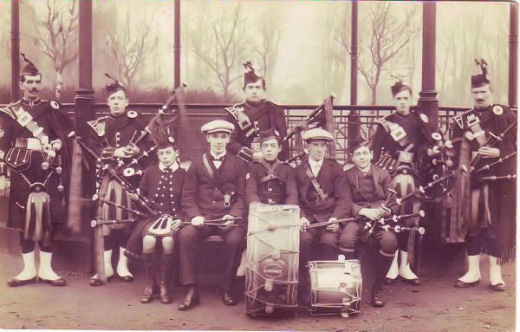
The first photograph we have of a Pipe Band actually parading in the Vale dates from June 1912 when an unnamed pipe band led 4,200 children attending the Vale of Leven Co-Operative Society’s Children Gala Day from the Public Park / Cricket Park at Riverside to Cameron Estate where a picnic was held. The photograph, shown below, was taken in Bank Street with the wall of the former Ferryfield Works on the left. The wall has long been replaced by the railings in front of St Mary’s school, while Bank Street has been widened.
As can be seen, it was not a large band – about 7/8 pipers, while the bass drummer is not wearing highland dress, suggesting that he may have been “borrowed” from an instrumental band, or equally possible, he just couldn’t afford the cost of a Highland dress uniform. It could well be the Vale of Leven & District Pipe Band whose photograph appears above – the bass drummer is not in Highland dress in either photo – but we just don’t know.
Band at Co-op children’s Gala Day 1912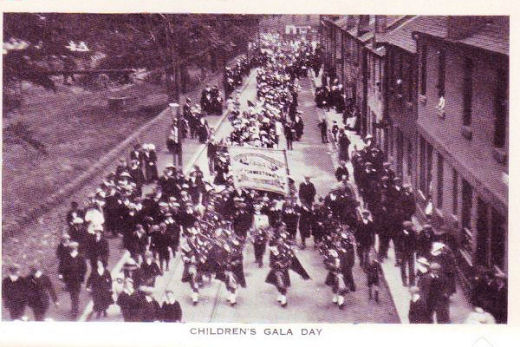
It is also known that there was a Scout Pipe Band of which the first President of BPPB, John Rogers, was the Pipe Major, and there are references to Boys Brigade Pipe Bands and an Argyll & Sutherland Highlanders Territorial Army Band in the locality. There were many individual pipers and drummers in the area who were available to tutor youngsters taking up playing. When the tutor had taken a youngster as far as they could, it was not uncommon for the young piper (in the Vale it was always a boy) to go to Glasgow to continue to be taught by a more experienced tutor.
So, there were many good pipe band musicians in the area in the late 1920’s and early 1930’s, and this had been so for many years. There were also a number of pipers locally who could teach piping to youngsters. The problem was that the piping musicians did not seem to be able to organise themselves into a successful and enduring band. No doubt the strong personalities which are commonly found in both the piping fraternity and the Vale in general did not make things easier in keeping a band together, but by 1931 things were about to change.
The Early Days Bonhill Parish Pipe Band
A number of young musicians – typically they were 20 / 21 years of age - decided to take matters into their own hands and form their own pipe band. They recognised their lack of experience in organisational and business matters, both of which were of fundamental importance to funding and running a band, so they deputed two of their number to approach a high-profile Vale businessman, John (usually known as Jock) Rogers, who was not only a local councillor but also had a plumber’s business in Bonhill.
As Jock himself recalled 21 years later at the Civic Reception held in September 1952 to celebrate the Band’s victory at Cowal,
“21 years ago last month, two boys came to see me in my workshop in Campbell Street, Bonhill, and asked me to attend a meeting in the Conservative Club Rooms. When I asked them what it was about, I was told “never mind, you’ll find out when you get there.”
These two boys were Pipe Major (P/M) Dick Hepburn and Leading Drummer John McLachlan. When I got to the Conservative Club Rooms, I found out that I was in the middle of a Pipe Band. I said that I would be their President if they promised to go to Cowal within three years.
We went to Cowal in our 3rd year and won the Harry Lauder Shield, the Scottish Shield and the second grade championship.”
A pipe band had been born, and not just any old pipe band but one which went on to climb the heights and on the way embed itself in the affection and respect of the people of Vale.
Neil Smith, who was associated with the Band from the start and was from 1933 the Secretary and then Treasurer of the Band, adds further details to that first meeting. “When John Rogers got to the Unionist Rooms in Bonhill he found not just the 2 young men who had come to his plumber’s shop in Campbell Street in Bonhill, but another 10 standing at a table playing chanters and 11 at a form rattling away with sticks. John Rogers took the chair, the Band was formed and office bearers were elected”.
Founder Members
We know who some of these founder members were, but not all of them. They included:
- Richard (or more usually Dick or Dickie) Hepburn, who was one of the driving forces for the formation of the Band, and became its first Pipe Major from the outset. This was a position he held, with the exception of 6 years in the forces during WW2, until he emigrated to Australia in 1949
- Hugh Smith, piper, a life-long friend and near neighbour of Dickie Henderson in Napierston Terrace, who went on to serve as Pipe Sergeant at various times.
- Jimmy Jackson, piper, who served as acting Pipe Major during the war years and became the Band’s Pipe Major after Dickie Henderson’s departure to Australia in 1949. Jimmy was the Pipe Major of the Cowal-winning Band in 1952.
- William Sloss, Drum Sergeant and first Band Secretary from 1931-33, he was a Band stalwart throughout the 1930’s.
- Willie Brechin piper, Pipe Sergeant and first Band Treasurer, a position he held for most of the 1930’s. Willie played in the Band throughout the 1930’s, although he doesn’t seem to have played much after the war.
- Pipers: Donald Hepburn, Danny Williamson, J Niblock, W Ronald,
- Drummers: Colin McInnes, who became Drum Major in 1933 in succession to John MacLachlan, J Williamson, John or James Forrest (he is referred to by both names at different times), Duncan Fraser, W Hepburn Snr, William Kenny.
- There were 3 other identified founder bandsmen, but we don’t know whether they were pipers or drummers. They were D Henderson, A Spottiswood, and J Wilson.
This makes a grand total of 19 musician founder members that have been identified, plus, of course, John Rogers, the non-playing President.
The first Office-Bearers whom these founding members elected in 1931 were:
- President: John Rogers
- Vice President: Colin McInnes
- Secretary: William Sloss
- Treasurer: William Brechin
- Drum Major: John McLachlan
- Pipe Major: Richard Hepburn
Although there were some changes in personnel and positions from 1933 onwards, most of these names continued to feature prominently for the rest of the 1930’s and in some cases well into the 1950’s. By 1933 Colin McInnes had taken over as Drum Major from John McLachlan, and was succeeded as Vice- President by David Patterson. Neil Smith had replaced William Sloss as Secretary. William Sloss continued as a drummer and band stalwart throughout the 1930’s. Neil later swapped roles with Willie Brechin, and served as Treasurer for about 20 years until his death in 1958.
The young members of the Band were confronted with many challenges in getting the Band up and started, not least of which was the financial climate of the time. 1931 was the absolute trough of the Great Depression and the Vale was one of the very most deprived areas in the whole of the UK with over 40% of the work-force unemployed at one stage. Spending money for many people was not so much tight as non-existent. Pipe Bands were then, as now, very expensive to kit out. Not only had instruments to be provided, but full Highland Dress uniforms for the bandsmen had to be bought too. True, some members had their own pipes, but most had not and all of the drums had to be provided. Another regular expense was paying for the premises in which to hold the practice sessions.
What seem even now to be pretty daunting tasks were met with great energy, enthusiasm and confidence. From the outset the first priority was practice – initially once per week but this was soon raised to two – and the Band led a nomadic life for a year or so in halls in Bonhill and Alexandria. The Unionist Rooms in Bonhill were used a few times to begin with, then Dalmonach School and Susannah Street Schoolroom, before the Territorial Army Drill Hall at the corner of Overton Street and Middleton Street became a base from about 1933 until the outbreak of WW2.
Naturally enough, practice was taken very seriously with hard work being the watchword. Practices were held on Mondays and Thursdays in the early years starting at 7.30 and lasting till 9.30. They were a means of evaluating not so much ability – there were informal or formal auditions with the Pipe and Drum Majors to do that before anyone was admitted to the Band – as reliability and commitment to the cause. That cause was of course performing and winning at Pipe Band competitions. From the outset everyone associated with running the Band had aspirations for it to be as good as it possibly could be.
Human nature being what it is, not everyone passed the reliability / commitment test and from 1932 onwards there are occasional references to someone leaving the band or being asked to leave the band or warned that his performance must improve otherwise he was out. The practice and the discipline worked, as we shall see.
Fund Raising
The other great challenge was fund-raising. Revenues raised by members’ subscriptions and payments were never going to make much of a dent on the required expenditure. There was an annual membership fee of 2/6d but that was not going to bring in more than £2-£3 per annum. There was also a weekly contribution sought of 6d to pay for the rent of the practice hall. As an indication of how hard up people were, the 2/6 subscription (about 12 pence in to-day’s money) could be paid up over 3 months, while the weekly contribution of 6d was halved for members who were unemployed. In a contribution list of late 1931 only 30% of those attending could afford to pay the full 6d.
So a wide variety of fund-raising schemes were devised, some of which raise a smile to-day. When did you last see a scented card for sale as a fund raiser, for instance? One scented card has survived in the Band’s files from the 1930’s. A very wide range of schemes were considered, but most were more conventional. They ranged from whist drives in the Susannah Street Schoolroom, which proved very popular, to weekly dances (St Mungo’s Church was a suggested venue, but unfortunately we don’t know the outcome of that approach), and Susannah Street Schoolroom was used for them as well.
Jumble sales and sales of work were run. Scottish concerts in the old Co-Operative Halls were suggested but don’t seem to have happened. Flag-days and house-to-house collections and the old staple of raffles were tried. There were football accumulators and schemes to acquire Scottish international tickets under assumed names and then raffle them off (the use of assumed names suggests that that would have been as illegal in the early 1930’s as it would be now). There was even an annual flower day. Imagination was as plentiful as the members’ energy and money was being raised from the autumn of 1932 onwards.
Perhaps the most urgent priority was to get drums, but the members were rightly reluctant to buy them if they could borrow them at this stage. Approaches were made to other bands in the area such as the Boys Brigade, Scouts and Territorials – although not it seems to either of the Instrumental Bands which were still on the go in 1931-32. Some drums do seem to have been lent to the Band for a time.
The next priority was uniforms, because the Band could not compete without a full Highland Dress uniform for every member. After a year of hard work at practice and raising money, the Band members were desperately keen to establish themselves in the competitive arena. By late summer 1932 they had decided in principle to buy uniforms. Committee members were in contact with major suppliers in Glasgow such as Lawrie, Henderson and Leckie Grahams.
The Ladies Committee
How to pay for them was still as issue. However, in the autumn of 1932 the members got smart and decided to form a Ladies Committee to help with the fund raising. A meeting was held on Thursday 13th October in Susannah Street Schoolroom at which the first Ladies Committee was elected to raise money to pay for the uniforms. Some of its members were Bandsmen’s wives, but some seem to have had no other connection with the Band. The members of this first
Ladies Committee were:
- Mrs Brechin Snr, Convener
- Miss Friel of Main Street Bonhill who was appointed Secretary
- Mrs Williamson, Treasurer
- Other members: Mrs Kenny, Mrs Brechin Jnr, Mrs Milne, Mrs MacNeil, Mrs Hepburn, Mrs Dalrymple, Mrs Owens, Mrs Sloss, the two Miss Jacksons, and 3 other ladies whose names are unfortunately not recorded. 16 members in all.
William Brechin, the Band Treasurer gave them all 2/6 (£2 in total) and asked them each to convert it to £1+ for the Band funds, which would net a profit of at least £14. This idea was common enough until the 1960’s: the money was used to buy ingredients for baking and tablet which were sold to friends and neighbours. It was further agreed that the Band committee would hold a joint meeting with the Ladies Committee every month.
The First Public Appearance
Perhaps gaining some confidence or re-assurance from the Ladies becoming involved, the Band pushed ahead on all fronts. On Sunday 30th October 1932 it made its first recorded public appearance in the Vale – although not yet kitted out – when it paraded with the Bonhill Boys Brigade to Bonhill Old Church (the Parish Church). A week later, perhaps to offer some balance, it led the 2nd Vale of Leven Boy Scouts to the same church.
In November 1932 the members chose the Band’s tartan in a vote – Royal Stewart getting 12 votes and Lochiel Cameron 9. In 1939 the tartan was changed to the Lennox tartan, but for the rest of the 1930’s it was Royal Stewart. It was further decided to have private rather than military dress as the basis of the uniforms. Orders were then placed for uniforms with Leckie Grahams, who sent a tailor down to measure each bandsman, and the uniforms were issued to the Band in April 1933, in time for the new competition season.
The list of items making up the uniform gives some idea of the expense involved. The Band’s uniforms comprised: brogue shoes, stockings and flashes, kilts, sporrans, jackets and vests, ties, Balmoral caps and feathers, pipe bag covers for the pipers, and most important in the Scottish climate, waterproof capes. You wouldn’t get much change out of £1,000 for these items to-day (for a single piper) and throughout the Band’s existence uniform replacement and maintenance was the major source of expenditure. It is not surprising, therefore, that when someone left the band, the first concern was not to replace him, but to get back his uniform, then they could worry about replacing him. Nor is it a surprise that The Band’s Quarter-Master’s job came to be a key committee position
First Issue of the Band’s Uniforms
We have a list of the 18 Bandsmen to whom the first set of uniforms were issued in April 1933, and it will be seen that there are a few changes from original 18 founder members that we can identify. It is quite possible that some of this 18 were founders, of course, but just hadn’t appeared in any records up until this point. The recipients of the uniforms were:
- Colin McInnes
- Danny Williamson
- John/James Forrest
- Donald Hepburn
- Alex Smith
- Hugh Smith
- W Proctor
- Jimmy Jackson
- John R Good
- R Good
- Richard Hepburn
- Hector Brown
- Tommy Williamson
- William Sloss
- William Brechin
- John Sinclair
- Tommy Smith
- William McLean, the Bass Drummer.
Although there is no record to confirm it, it is a fair assumption that this was the line up which launched Bonhill Parish Pipe Band’s competitive career in May 1933.
As the 1933 competitive season approached, the Band could look back with some satisfaction on the previous 20 months. It had worked hard and practised even harder to mould a competitive band. It had used the winter and spring of 1932-33 for further fund-raising and to put itself before the Vale public.
One of the highlights of this was a piping and dancing competition which it held in the Co-operative Halls in Bank Street Alexandria in March 1933. It was very well attended and piping prizes were picked up by Jimmy Jackson and Dick Hepburn, while a young Donald McDermid won 3rd prize in the competition for members of BB and Boy Scout Bands in Dumbartonshire. Dancing prizes went to Cathy Stewart and F Wilson both from Alexandria, amongst others. Some of the prize-winners are in the accompanying photograph.
Prize winners at a Band Piping & Dancing Competition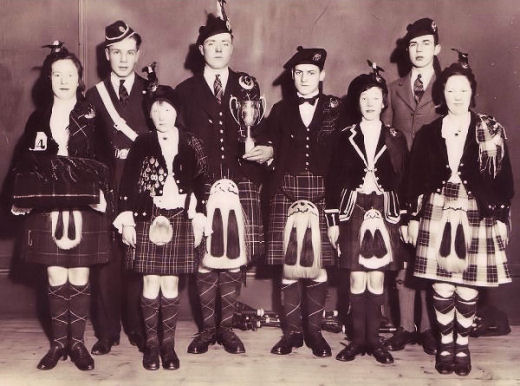
The Band had played in public in the Vale a number of times now, and had on its own initiative gone further afield in its brand new uniforms to entertain. In April it travelled to Gartmore and Buchlyvie unannounced, stepped off the bus and started to play and parade. The press reports of the time are eloquent testimony to the very positive impression which the Band made in these villages. They followed it up with later trips that year to Aberfoyle and Balfron. There was method in the madness of these “up country trips” (the Band’s own phrase at the time). Strathendrick Cattle Show, Buchlyvie Show and Kippen Flower Show engaged the band to play at very handsome fees - £7-10/- in the case of the Cattle Show.
As has already been noted, this was more than 3 times what was being brought in by annual subscriptions. The village parades were also a final dress rehearsal where any glitches could be ironed out away from any hyper-critical locals, before the Band’s first entry in the Pipe Band competitive arena.
1933 Onwards – A Very Public Band
Fully kitted out, rigorously rehearsed and brimming with confidence, Bonhill Parish Pipe Band was about to make its competitive debut. On 27th May 1933 in the Public Park at Alloa it paraded at the Mar Pipe Band Contest. Competing in a class of 16 in Grade 2, the Band secured 3rd place behind Rutherglen Rechabites and Shotts & Dykehead. A 3rd place at their first attempt well exceeded the Bandsmen’s expectations, if not their wildest dreams. A measure of how pleased the Bandsmen were with this performance and result was that on the return journey from Alloa, they stopped the bus on the east side of Stirling and played their way right through the town to Dumbarton Road. The Band was on its way.
First Appearance at the Cowal Gathering
The Band’s next major appearance in 1933 was at the Cowal Gathering in August, and if Alloa was a very good start, Cowal was an even better follow up.
On Saturday 26th August, competing at Cowal for the first time, the Band secured the following trophies:
- General Band Contest No 1 – 3rd Prize – MacAlpine Shield Challenge Trophy & £6
- General Band Contest No2 - 2nd prize - Walter Scott Challenge Trophy & Silver Medal
- General Band Contest No3 - 1st Prize - Benmore Shield and Gold Medals
As an added bonus, the Band was placed 8th in the World Championships, pretty good for its first season. This time we know exactly who was in the Band for its first Cowal appearance. The line up was:
- Drum Major Collie McInnes
- Pipe Major Dickie Hepburn
- Pipe Sergeant Willie Brechin
- Piper Hughie Smith
- Piper Donald Hepburn
- Piper Hector Brown
- Piper Tommy Smith
- Piper R McNaught
- Piper H McInnes
- Piper John Sinclair
- Piper Danny Williamson
- Piper Jimmy Jackson
- Drum Sergeant Alex Smith
- Drummer Willie Sloss
- Bass Drummer William McLean
- Drummer Tommy Williamson
- Drummer John Good
- Drummer R Good
Missing from the band that day were J Forrest and W Proctor, but Piper H McInnes had joined since earlier in 1933.
The Band’s performance exceeded the target which John Rogers had set for the members on the night the Band was founded in August 1931. They had not only competed at Cowal within 2 years, they had also won at Cowal within 2 two years.
A week later, on Sept 2nd 1933, the Band followed up its Cowal performance by winning 1st prize, the Renfrew Challenge Shield & £8 at Renfrew Pipe Band contest. An interesting aside to that victory is that for the journey to it, the band took the train from Alexandria to Yoker, walked down to the Renfrew Ferry, carrying all of its instruments, of course, crossed the Clyde on the Renfrew Ferry and then walked up from the Ferry to the competition field. In case that seems a bit tough, the route did take them past at least 6 pubs in those days, so you might guess that the return journey was a bit of a breeze.
The Band fully deserved these competitive victories because it had put in an enormous public effort in the spring and summer of 1933. Between March 25th and September 2nd the full band had paraded on no less than 35 outings, while it had supplied pipers to another 3 events. Some of the appearances were competitive, many were in support of charitable organisations, some were fee-earning / fund raising and others were what we would now call public-relations.
Charitable parades included leading the 3rd Vale Scouts to St Mary’s Church, the Bonhill Parish Church Sunday School to Balmaha, a Boys Brigade Parade, playing at the Vale Academy Sports at Millburn, leading the St Mary’s School outing to Helensburgh, playing at the Methodist Church Flower Pageant, and leading “The Huts” annual trip.
Fee-earning / fund raising came in various forms. The Band played a number of times at the Vale Emmet’s football matches at the Emmet Park, where it took up a collection (Vale of Leven FC was in abeyance throughout most of the 1930’s). As well as the shows “up country” for which it was well paid, it played at the Dumbartonshire Cattle Show and at various Vale political demonstrations for which it collected fees.
Its Public Relations parades were a combination of casting their bread upon the water – as in the trips to Aberfoyle, Balfron Buchlyvie etc – and saying thanks to their supporters in the Vale with parades in Jamestown, Bonhill Balloch and at the Fountain. Although etiquette did not allow it to parade in Renton – the Renton Pipe Band would have had something to say about that – it did play in Levengrove Park, which was quite appropriate since a number of the Bands members came from Dumbarton and a few of them from the Clydebank area.
All of these appearances and parades caused considerable wear and tear on instruments and uniforms as well as bandsmen, but it was also very useful practice in playing and parading. Also on the upside was the fact that by the end of 1933 practically everyone in the Vale had heard the Band, which was by now well on its way to becoming a Vale institution.
The 1933 Prize-Winning Band photographed behind the Vale Masonic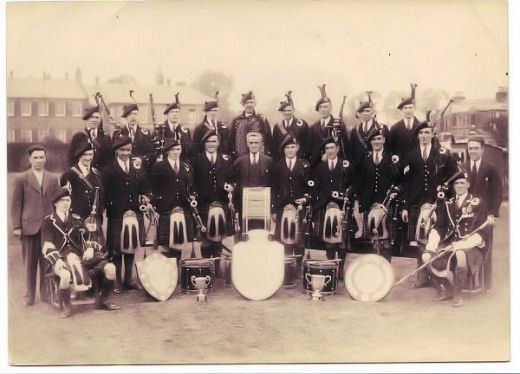
This 1933 photograph is historic in more ways than one. Firstly, as has been said, it is the first photograph we have of the Bonhill Parish Pipe Band, taken in its first year of competing. The trophies along the front include, from Cowal, the MacAlpine Shield, the Walter Scott Challenge Trophy, The Benmore Shield and from Renfrew, the Renfrew Challenge Shield. Seated at the front are Pipe Major Dick Hepburn on the left, and Drum Major Colin McInnes on the right. Standing behind the bass drum is the President Jock Rogers, while Secretary Neil Smith is standing on the extreme right. Other identified musicians are piper Danny Williamson (back row second from the left), Pipe Sergeant Jimmy Jackson (front row, second from the right) Piper Hugh Smith (front row fourth from the right) while the Bass Drummer in the middle of the back row wearing the leopard skin is William McLean from Clydebank.
The photo is taken behind the Masonic temple on a piece of land which disappeared in the early 1950’s under the present Telephone Exchange and Lennox Hall. The former Vale of Leven Academy (now the Christie Park Primary School) is in the background, including the long-demolished technical and domestic science building on the left, and the small imitation bell tower on the roof of the main school building which was removed in the 1950’s.
It also shows the Band in its original tartan and sporran. Until August 1939 the band tartan was Royal Stewart, and the number of tassles on the sporrans was two. About August 1939 both of these were changed. The tartan was changed to the Lennox Tartan, while at that time the number of tassles on the sporran was increased from 2 to 3. It is beyond recall why the changes were made, but they are now very helpful when trying to identify the date of photographs as well as who therefore might be in them – 2 tassles, it’s pre-war, 3 tassles it’s post-war.
Inside pages of a 1930s Bonhill Parish Pipe Band Membership Card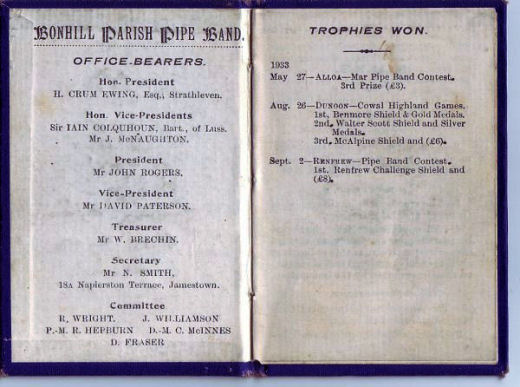
Group of Bandsmen with 1930’s tartan and tassles.jpg)
The above photo shows some of the bandsmen wearing Royal Stewart tartan and two tassles in their sporrans. They are not wearing their tunics and are clearly in a relaxed mood.
This was the start of a run of victories in the 1930’s which included both solo efforts and the whole band. In September 1933 at the Dalmuir piping competition Pipe Sergeant Willie Brechin and Piper John Sinclair won 3rd prize in Slow March and Strathspey & Reel respectively, while piper Jimmy Jackson won first prize for the Best Dressed Piper, a standard he always maintained.
In 1937 Pipe Major Dick Hepburn won the only solo piping competition which he ever entered in Scotland, at the Argyllshire Gathering in Oban. He was still winning top-grade solo competitions in Australia nearly 40 years later. He came originally from Napierston Terrace, Jamestown, and was taught to play the pipes by his uncle, who later transferred him to noted pipe tutor John McColl in Glasgow. Dickie had the strong personality needed to forge success in the new pipe Band and was the unofficial leader of the Band.
After he emigrated to Australia in 1949 Dick continued his successful P/M career in Australia for many years and created a new one as a solo piper into his early 60’s. A full account of Dick’s hugely successful piping career in Australia can be found at www.schoolofpiping.com where on the Articles page there is an article “Dickie Hepburn’s Silver Martin Bagpipe”. Some of the dates about his Scottish piping career are wrong, but Dickie’s Australian achievements speak for themselves.
British Open Champions 1938
By 1938 the Band had achieved the coveted Grade 1 status which was the aim or at least dream of every band. The Bandsmen were up there amongst the longer-established leading bands of the day, and were about to join the very top echelon of pipe bands by winning the 1938 British Open Pipe Band Championship – the Band’s finest achievement to date. At the same time the Band made its first recording on 8th April. Unfortunately, neither that recording nor others which the Band made, including tapes of radio appearances on the BBC, seem to have survived, in spite of searches of the BBC archives.
The Band is photographed below on the steps of Strathleven House, the home of the Band’s Honorary President Mr Humphrey Crum-Ewing in 1938 with its various trophies.
Winners of the British Open Championship 1938
in front of Strathleven House
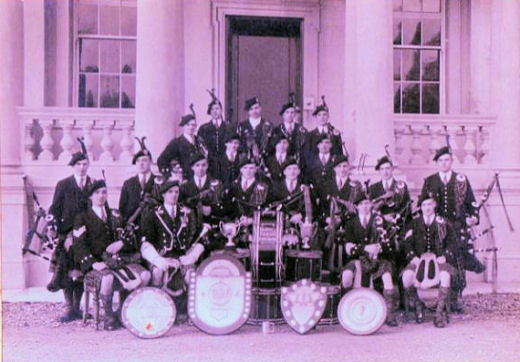
There are 20 musicians in this William McKim photograph, which is at the top end of the numbers that the Band usually paraded. At the time, the rules of Grade 1 competitions, as laid down by the Scottish Pipe Band Association, required at least 8 pipers and a minimum of 4 in the drum corps, although most bands, including BPPB, usually seem to have paraded a minimum 14. (For those of you who think that the front door of Strathleven House must have changed since then, you are, of course, quite right. The restorations from 1986 to 2001 saw the return of the external staircase at the front which had been removed 150 years before).
So as the 1930’s came to an end the members could look back on the previous 8 years with pride and satisfaction. They were one of the most prominent Grade 1 Bands on the competitive circuit with a solid record of achievement. In addition to the prizes already mentioned, the Band’s wins, which they put onto the 1940’s letterhead, included:
- Renfrew Shield (Twice)
- Mar Challenge Cup
- McDermid Shield
- Markinch Burgh Trophy (Twice)
- McNiven Cuthbertson Cup
- Strathforth Cup Inverkeithing
- Proctor Cup Alloa
- McFarlane Shield, Cowal (Twice)
- British Open Championship (1938)
- 1st Prize Inverkeithing
- 1st Prize Crieff
Not a bad record for a band which only started competing in 1933.
Bandsmen sitting on the grass, perhaps in the Christie Park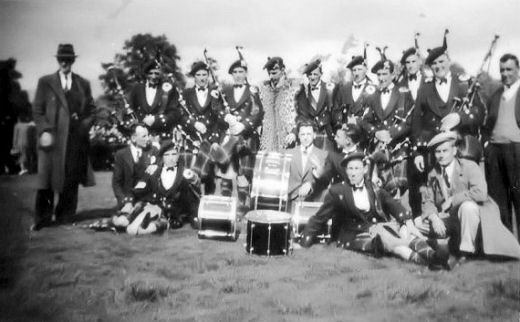
An important part of this success was due to the backroom organisation which had supported the Band almost since its founding. After the initial burst of fund-raising enthusiasm which paid for the Band’s first uniforms, equipment etc, the scale of the challenge of meeting the Band’s running costs set in – maintenance of the uniforms and instruments being the most obvious, but hall rental and travelling costs were also expensive. Bandsman had to devote a lot of their spare time to practice, so it was unrealistic to expect them to have much time for fund raising. Sponsorship was unheard of. A large part of the solution has already been touched on – the Ladies Committee which had been formed as early as 1932.
Mrs McEwan’s Committee
In 1935 the Ladies re-organised themselves into a Uniform Committee under the chairwomanship of Mrs McEwan who proved herself a formidable force in raising money and perhaps as importantly, spending it wisely. Over the years the Uniform Committee evolved into a formal Ladies Committee which was an integral part of the Band. Its main function was to raise general funds for the Band over the next 20 and more years. This was no “seen and not heard” group but was an equal part of the Band, attending Committee Meetings on the same basis as their male counterparts. So powerful was the Ladies Committee that on the few occasions on which it chose to exercise it, it proved to have the power of veto over the Bandsmen. In terms of Vale clubs and organisations and the status of women, Bonhill Parish Pipe Band was decades, perhaps even centuries, ahead of its time, and it paid handsome dividends for the Band.
WORLD WAR 2
The outbreak of war in September 1939 ended all competitive Piping for the duration, to say nothing of changing everyone’s lives. From 1940 onwards the Band essentially went into hibernation until the autumn of 1945.
The Band members were soon spread far and wide either in the forces or on war work. Pipe Major Dickie Hepburn went into the Seaforth Highlanders in 1940, and didn’t return until 1946. Hugh Smith and Donald McDermid also joined up and are next heard of again in the autumn of 1945 when they are minuted as attending the first General Meeting of the Band after the war in September as “Home on Leave”.
Two members did not return, having been killed on active service.
Piper Lachlan McLean Brown who served in the Cameron Highlanders, died in a German military hospital in 1943, having been made a prisoner in the ill-fated pre-Dunkirk campaign in the summer of 1940. He was 26 years of age when he died, having been born in 1917.
Drummer Duncan Fraser was a founder member and a member of the first Band committee, being born in 1914. He was a sailor on HMS Niger and died in the cruellest of circumstances in July 1942. HMS Niger was on Russian convoy escort duty, which was the most dangerous and arduous tour that a RN ship could have in WW2. It was on what had proved to be a very dangerous return leg from Murmansk and carrying survivors from the cruiser HMS Edinburgh, which had already been sunk, when disaster struck. Nearing Iceland and back under the relative safety of Allied air cover a navigational error in bad visibility caused it to mistakenly turn into an Allied minefield just off the coast of Iceland. Almost immediately HMS Niger struck a mine and sank. Duncan Fraser was among the 149 sailors who were lost. There were only 8 survivors.
There may have been meetings and practices up until 1943, since there was a financial report for that year, but there were no further written records until 1945. However, the core of the band still seems to have functioned during the war years and President John Rogers and pipers Jimmy Jackson and Jackie McIntyre are credited with achieving this.
Jock Rogers and others with a military band in the Christie Park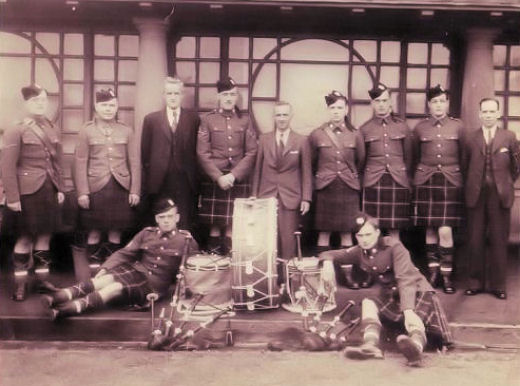
This is the only Band photograph which can definitely be confirmed as having been taken during the war, and even at that there are no Band musicians in it. It shows Band President Jock Rogers and other Band committee members with bandsmen from an unidentified military pipe band. At a guess, this was a courtesy meeting with the band which could well have been playing in the Park, perhaps at one of the “Holidays at Home” events which were regularly held in the Christie Park during the wartime summers, but that is only a guess.
There are very few photographs of any sort of military presence in the Vale during the War. There is only one of soldiers parading and it is shown below as they are led by the Band. The soldiers are marching along Main Street, Alexandria, and are just passing the top of King Edward Street when the photograph was taken. As can be seen, no arms are being carried, so it possibly could be a Church Parade, but equally, given the weather and the proximity to the Park, it could also be that it is heading to a Remembrance Day Service at the Cenotaph. This is, again, just speculation since neither date nor purpose are now known but it seems to have been a formal event because the Band is in full dress uniform..
Band leading parade of soldiers in Main Street, Alexandria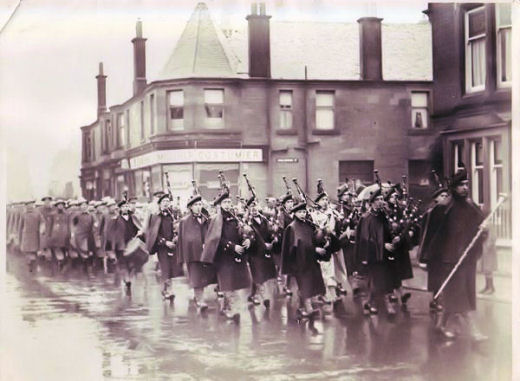
A couple of the Band members can be identified. Leading the parade is Drum Major J Tait, and on the extreme right of the front row just over his shoulder is piper Jackie McIntyre.
Getting Back Together
In 1945 the members began to re-assemble to get the Band functioning again. There were, of course, many members of the Band still in the forces, but a list of those attending the first General Meeting of the Band after the War, held in Main St School, Alexandria, makes interesting reading. Those present were recorded as:
- Messrs Rogers, Kerr, Paul, McIntyre, Campbell, Young, McEwan, Kenny, Dempster, McNicol and Urquhart, who seem to have been the non-playing members, although some of them were former pipers and drummers.
- Tait, Jackson, McIntyre, Love, Collins, McNaught, McFarlane, McKenzie, Erskine, Harden, Sloss, Cochrane, Good, Wright and Lennie. These seem to have been the playing members.
- Home on Leave: H Smith, D McDermid
The Band could therefore muster 15 playing members plus the 2 members who were Home on Leave. Others, particularly Pipe Major Dickie Hepburn were still in the forces and would not be available for the foreseeable future. However, the members immediately set about their business as briskly as possible “now that hostilities were over”, under the continuing presidency of Jock Rogers. He was able to report that the Band was in a “very healthy position indeed” financially and the meeting proceeded to elect the following committee:
- President: John Rogers
- Vice President: J Urquhart
- Secretary: J Tait
- Treasurer: J Kerr
- Quartermaster: W Kenny
- Committee Members: John Campbell (Christie Park), Mr Paul (Balloch), Alex McEwan (Bonhill), John McIntyre (Bonhill), William Dempster (Bonhill), Mr Young (Jamestown), Peter McNicol (Alexandria).
It is apparent, therefore, that even allowing for the known absentees, there had been a number of changes of personnel from 1939. However, Band founders like William Sloss and Acting Pipe Major Jimmy Jackson were still available in 1945 and well to the fore. It was noted at that meeting that John Sinclair had resigned and people were unsure of the whereabouts of William McLean the Bass Drummer, which was a key position in the Band. However, William McLean re-appeared at the next meeting and was promptly added to the Committee.
There was therefore a pretty full complement of pipers and drummers as early as the autumn of 1945, which was just as well because the Band was in great demand from then onwards for many community functions in Dumbartonshire such as Remembrance Day parades and parties celebrating the successful end of the war.
Fund raising and social life also took a high profile in the winter of 1945, often going hand in hand, and a number of Band traditions were established or perhaps re-established then.
The Highland Ball
High on the priorities was re-creating a peacetime social life, including the holding of the annual Highland Ball. The first post-war Ball was held on 1st February 1946. The Ball became a great Band highlight in the 1940’s and 50’s, and it also throws some interesting light on other aspects of Vale life at the time. It would be hard to exaggerate the enthusiasm with which Band members embraced the Ball or the fondness of the memories of the attendees, even after all these years.
Highland Ball Couples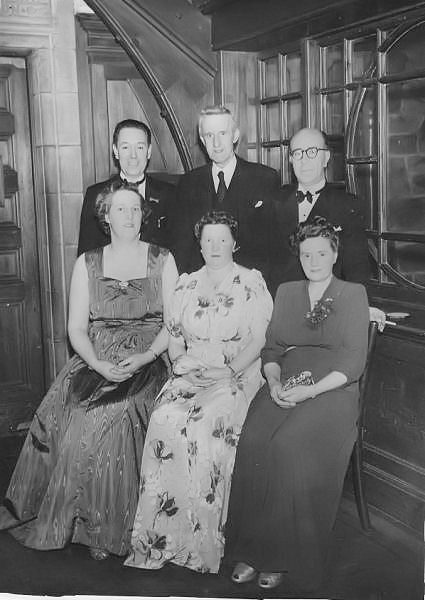
The primary aim of the Highland Ball was, of course, for the Band members, patrons and friends and their spouses and partners to get together to enjoy themselves, which was something that came naturally to them all anyway. The stamina which they must have needed to see the evening out was a very useful by-product of the affect on the lungs of the bag-pipe playing and hefting the drums about. And a great deal of stamina was needed. A typical Ball lasted from 8.00pm until 2 am, always on a Friday night, since you couldn’t get a late licence beyond midnight on a Saturday, and the dancing was not for the faint-hearted. Some the dance programs are shown below.
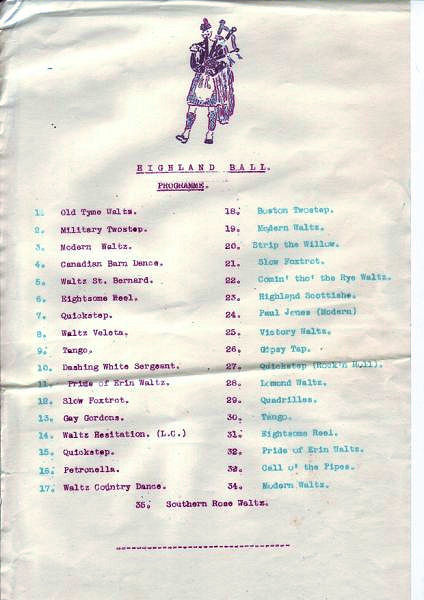
Highland Ball Program 1 - undated
In the interval between the 2 sessions of dances which comprised about 17 / 18 dances per session, a full purvey was served. The impact on the digestive system of all these reels and jigs hardly bears thinking about. When you look at the photos of the attendees at the Balls, with everyone looking in pristine condition, you’ve got to believe that they were taken at the beginning of the evening.
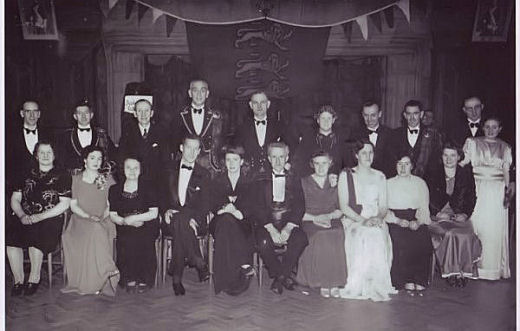
Highland Ball Couples
The organisers had three main concerns – where to hold the Ball, who would provide the purvey, and which band would play at it.
Various venues were considered over the years and some tried, such as the Bungalow Tea-Room shortly after it opened in 1951, but the Highland Ball was almost always held in the Masonic Temple, Alexandria. The venue dictated the number who could attend and by the early 1950’s that had been set at 75 couples or 150 people in total.
A number of dance bands were used over the years, starting with Cannon’s Band in 1946 and then Mr Irwin’s and David Somerville’s Nite Lites in later years. A typical 5 or 6 piece band cost £10 10/- in the 1950’s, which is pretty good value for playing from 8pm until 2am.
Similarly, a number of businesses were asked to tender for the purvey including the Co-op, Patterson’s, Arcari's. The typical price was 5/- per person which was about half of the cost of the ticket. It seems to have been good value, because everyone partook of the food and there had to be 2 sittings, based on ticket colours, during the Ball
The Highland Ball was a great success and competition for tickets was pretty fierce in spite of the fact that dress was formal and many people must have had to hire evening suits to attend. In a short time the Ball had become one of the social events of the year in the Vale and lasted until the Band stopped playing.
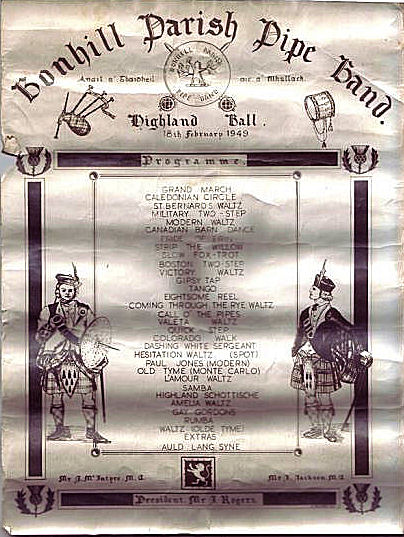
Highland Ball program dated 1949
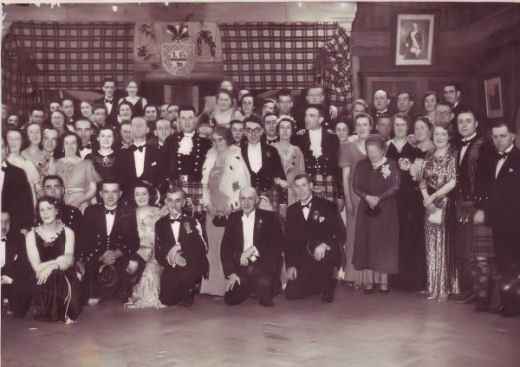
Highland Ball large group
Playing at Millburn
Right from the 1945 AGM, the Band’s thoughts turned again to fund raising. One of the first ways of making money that the Band considered was parading at football matches at Millburn and taking a collection in a sheet while marching round the track. This was a suggestion from a member of the public and it turned out to be a lucrative one. While neither playing at Millburn nor at football matches was a new experience for the Band, playing at the Vale’s matches was.
The club had re-formed as a junior football club in August 1939 and although friendly matches had been played at Millburn during the war, all competitive matches were suspended. As soon as the leagues and cups resumed in 1945, crowds flocked back to see the Vale. In the 1940’s and 50’s, a typical Vale home crowd was about 1,500 while cup-ties would get double that and even on occasion over 5,000.
The Band marched round the pitch before the match and at half-time and a lot of money could be collected. The first game at which the Band played was in December 1945 and the financial potential was such that by the spring of 1946 the Band in effect sub-contracted the collection at the matches to the local Rover Scouts, who were in turn paid 25% of the take for their efforts. The first such “joint venture” was a Cup-tie against Ardeer in February / March 1946. Cup-ties at Millburn remained a lucrative source of money for the Band until well into the 1950’s.
Band at Millburn about 1946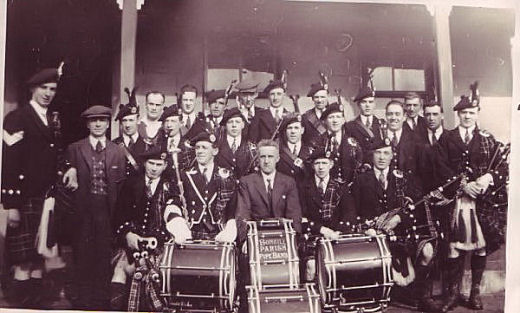
The Ladies Committee soon re-started its fund-raising activities under its Chairwoman, Mrs McEwan. It was often described as “her” Committee and by all accounts that’s an accurate enough description. Mrs McEwan attended Band Committee Meetings, as did Mrs McIntyre and Mrs Gillies, from March 1946 onwards, whenever any matter in which the Ladies might have an interest was under discussion.
Their interest extended to how money was being spent, as we shall see below, but in the spring of 1946 it was centred on how to add to the money which it had had in the Bank since 1940. The favoured route was to hold monthly dances and social evenings and the first one was held in March 1946. Typically they were held on the second Friday of each month from October to March, in the Susannah Street Schoolroom.
The Band was for many years Messrs Logan and Wilson who were paid the princely sum of 30/- per dance. Since each dance generated about £3-4 profit after expenses, and tickets were 2/- each, they must have been well attended, filling the old Schoolroom. £4 was about half of a weekly wage in those days, so the dances were making a valuable contribution to Band funds.
Parading in the Community
Right from November 1945 requests started to flow in again for the Band to parade in support of various local organisations. The first public appearance by the Band after the war was in the British Legion Armistice Parade to Christie Park on 11th November 1945, which appropriately enough fell on a Sunday. The Armistice Day Parade became an annual fixture in the Band’s calendar.
Other regular appearances such as at the Cattle Show were also resumed. The Vale District Council gave the Band a number of bookings to play in the Christie Park, and the District Council was to prove generous with regular bookings to play throughout the area in the coming years. The Christie Park was also used for the Band’s Flag Day, with the addition of Highland Dancers from 9pm – 11pm. The Vale of Leven Athletic Club wanted the Band to play at its Sports Day at Millburn.
In addition, a unique feature of 1946 was the number of Victory celebrations at which the Band played throughout the area. These included the Dumbarton Parade in June 1946, the Helensburgh Victory Celebrations, and the Vale’s own one based in the Christie Park, which was held on the 29th June 1946. The Band collected useful fees for these appearances - £15 from Dumbarton, £10.10/- from the Vale District Council,
Another unusual, if not unique, feature of 1946 was how prepared Pipe Bands were to help each other out with pipers and drummers for local parades that year. Bonhill provided pipers and drummers to Helensburgh and Renton, and in turn asked Dalmuir for help with a fund-raising event. This was hardly surprising, since so many bandsmen were still in the forces for much of the year. Although the Scottish Pipe Band Association was working hard during 1946 to get competitions restarted, the Pipe Band scene as a whole was missing many fine players who were still in the forces.
A number of players from the 1930’s had either not returned to the Band or had decided to retire from playing. The lack of drummers was so critical that it was decided to advertise in the Lennox to try to attract new players. One key person who did return to the Band was Dickie Hepburn, who was demobbed in January 1946. The Band now began to regroup and assess its playing situation – who was still a member, where the gaps were, and what the state of playing competence was. All were agreed that hard practice and tuition, and a filling of the gaps were urgently required before the Band could return to competing. In fact, Bonhill only seem to have played in one contest in 1946 – at Edinburgh in May – and although it considered entering contests at Dumbarton, Inverkeithing and Cowal it didn’t do so because of “difficulties in obtaining the necessary strength”.
However, the Band continued to practice hard and even if it was not quite strong enough to compete that year at its Grade 1 level, it was more than good enough to parade in the Vale, where as we have seen, it was in great demand. 1946 and 1947 also saw the recruitment of a number of musicians.
The Cowal Question
In the Pipe Band world, 1947 proved to be the start of a couple of years of turmoil. A dispute arose between the Cowal Gathering and the Scottish Pipe Band Association, now the Royal Scottish Pipe Band Association (“RSPBA”), over the ownership of the Piping World Championships. The SPBA was actually only 1 year older than BPPB having been established in 1930. It started as an umbrella organization to sort out rules of competition, equipment standards, registration of band members, arbitrator of disputes between bands etc.
Throughout the 1930’s it slowly but steadily established its authority in these functions, so that after WW2 there was acceptance that the SPBA was the owner of rules governing Scottish Pipe Bands (and soon Bands throughout the World who played in the Scottish style), that disputes between Bands which could not be settled otherwise would be referred to its judgement, that it organised the annual competitive program, and most importantly that only Bands registered with it could enter these competitions. Crucially, until 1947 it did not organise any competitions itself.
The Cowal Gathering was much older than the SPBA, having been started in 1894. Piping was added in 1906, and the Cowal Piping Championship was advertised as the “World Championship”. Since there was no such event anywhere else at the time, there was no argument from anywhere, and the Cowal was accepted as the de facto “World Championship” by the whole Pipe Band community. No one thought that there was any need to register the name. The event grew in stature and numbers over the years, and was universally regarded as the premiere event in the pipe band world.
And that was how things stood until 1947. When Edinburgh decided to start the Edinburgh International Festival in 1947, the SPBA saw this as an opportunity to grab the World Championship title for itself and incorporate it into the inaugural Edinburgh International Festival. For once, Edinburgh seems to have been innocent of the well-founded charge that it always tries to grab everyone else in Scotland’s good ideas for itself and although the SPBA had a case when it aspired to create and run a new World Championship under its own control and independent of Cowal, it could certainly have gone about it in a more conciliatory and diplomatic way.
It is said that they asked Cowal to hand over the title, and not unnaturally Cowal refused. The evidence now suggests that the Cowal organisation went out of its way to compromise and that it was the SPBA which was intransigent. The SPBA decreed that any band which played at Cowal would not be allowed to play in SPBA-sanctioned competitions. Fortunately, this dispute and the ban did not last long – it was resolved in 1949. However, to this day, against reality and logic and commonsense, the RSPBA refuses to recognise the Cowal winners pre-1947 as World Champions.
Bonhill Parish Pipe Band navigated round this dispute with some skill. In this it was no doubt helped and influenced by William McLean, who was not only the Band’s Bass Drummer of long-standing, but also a member of the Executive of the SPBA, of which he became the President in 1948. While the President of the SPBA he was still attending the Band’s committee meetings when he could, adding words of wisdom whenever he felt it to be appropriate.
The Band did defer to the SPBA on a number of matters such as members joining from other Bands and property disputes with other bands. It was a very well administered Band anyway, but his advice on inter-band matters and pipe band politics as a whole was a great help at this time, because the SPBA always found in the Band’s favour. McLean was a very busy man outside of the Band – he was a Trade Unionist and Town Councillor in Clydebank and went on to hold senior positions in the Council including Baillie.
During the SPBA – Cowal dispute, Bonhill never actually took a public position on the issue – for instance, it never said that it would observe the ban and not go to Cowal, and thus did not alienate Cowal.
On the other hand, it did support the SPBA’s actions in a number of low-key ways. For instance, the SPBA did not have any trophies of its own before 1947 – it did not need them until then since it had never organised any competitions before setting up the first World Championships in 1947. At Drummer McLean’s request in the summer of 1947 the Band agreed to lend the SPBA two Band trophies to be presented at the World Championships – the Ben Lomond Shield, and the Crum Ewing Cup. Also, the Band entered these Championships which were held in Edinburgh.
In private committee discussions at the time it is clear that the Bandsmen’s sympathies were with the SPBA, mainly on the basis of the prize money on offer. There was a feeling that the Cowal organisers were exploiting the Pipe Bands by not offering sufficient prize money nor looking after the Bands properly on the day. The SPBA, on the other hand, was holding out the prospect of sponsorship money pouring into the Pipe Band Community from the World Championships, and that did happen over time. Organisers of other competitions such as the Scottish Championship had already started to pay every band which entered the Championships.
They also looked after bandsmen’s needs on the day of the competition. So although Cowal had moral right on its side, it had to do better in keeping the Bands happy – something which it addressed when the dispute was over.
The First World Pipe Band Championships 1947
As has been mentioned, the Band competed at the inaugural official World Championships in Edinburgh in 1947. The Band treated this event with a great deal of respect – it was the most important competition which it had entered since the end of the War. It took a large travelling support with it, in at least 6 buses, and it paid Pipe Major Dickie Hepburn’s expenses for breaking his summer holiday on Islay to travel to Edinburgh. The efforts were well rewarded. The Championship was won by Bowhill Colliery, Clan McRae was 2nd and Bonhill Parish Pipe Band was rated in 3rd place. Bonhill Parish was very much back in its proper place as a leading in Grade 1 Band. During 1947 the Band also won a trophy at Bargeddie, and its placings in various other competitions brought it total prize money for the year to £80, not a bad start for its return to competitions.
Strathleven first post war photo, about 1947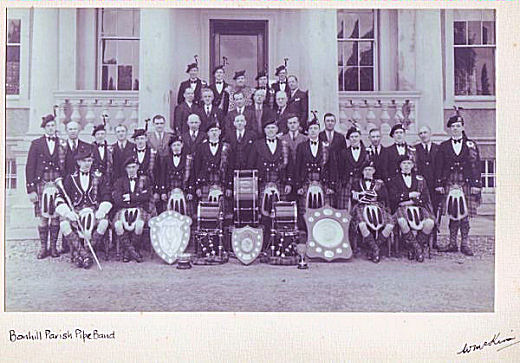
The AGM in October 1947 proved to be eventful. Firstly, J Tait, who was not only the Drum Major but also the Secretary, left the Band to be replaced as Secretary by AB McGuire. The Drum Major’s position was filled a week or so later.
The Ladies Flex their Muscles.
The next upset was a revolt by the Ladies Committee over a proposal to double the Pipe Major’s Honorarium from £10 to £20. The Ladies, who were in attendance in strength, made it clear that they would all resign, effective immediately, if the Honorarium was doubled. Nobody doubted that they would resign and everyone was well aware what an important part the ladies played in not only fund raising but in the smooth running of the Band. The motion was hastily withdrawn, but the threat of resignation was not. A further meeting was needed to resolve the matter. The issue was not whether the Honorarium should or should not be increased; it was quite simply that the ladies thought that they should have been consulted on what was a matter of spending money which they had raised. It was game, set and match to the ladies and the men, suitably chastened, always consulted them on such matters thereafter.
A New Drum Major
A week or so later, another Band character came on the scene for the first time – Jimmy Kelso. Jimmy applied for the vacant position of Drum Major and after a very brief interview he was duly appointed. Jimmy was at that time the Drum Major of Renton Pipe Band and the committee obviously expected that there would be some sensitivity in the Renton band about this appointment. Jimmy was the committee’s unanimous choice, but it took the precaution of offering him the position “as and when free to take up his duties”. These duties were defined as “Take responsibility for Band discipline and deportment on Parade. To demonstrate and give instruction on marching and counter-marching etc. The Drum Sergeant being responsible for Drum instruction only.”
The secretary of BPPB was instructed to communicate with the Secretary of Renton Pipe Band, Mr H McLean, of Tontine Avenue, Renton about the appointment and the waiting period.
Jimmy Kelso leads Renton Pipe Band as Drum Major
The committee was quite right to expect some repercussions from Renton, because the following week, on Mon 3rd November 1947 Renton Pipe Band’s chairman, Mr Mayes, and Secretary, Mr McLean, met the BPPB to discuss Drum Major Kelso’s appointment. It seems that Renton felt that D/M Kelso had been poached by Bonhill. They were explicitly assured that no official approach had been made to Mr Kelso by BPPB, nor had any executive official of the band approached him.
They were satisfied with the explanations given and with the way in which the matter had been handled by the Committee. They agreed to release Mr Kelso immediately and departed with the normal relationship restored.
So from November 1947 the Band had a new and imposing figure leading them out front. Jimmy had been in the army during the war and had a military bearing which gave him an imposing appearance as the archetype Drum Major, complete with mace and appropriate swagger. And the image did not lie. Jimmy was a strong believer in discipline, smartness and visual impression realising that, while visual impression alone wouldn’t win competitions, it won favour with spectators at competitions and social events. The Bonhill Parish certainly looked the part and with its very smart appearance proved to be a great crowd pleaser, which helped enhance its reputation.
Going into 1948 Dickie Hepburn was doing his best to ensure that the Band sounded the part too. Early in the year P/M Hepburn had doubled practice, and a number of new young bandsmen had been recruited. The overall efforts started to pay off: in May P/M Hepburn reported a great improvement since the start of twice weekly practice, while Drummer McLean said there was good chance of the Band “making history in 1948”. D/M Kelso on the other hand said that marching and deportment were still weak and the band needed working on to prevent slovenly habits – just in case anyone was thinking of slacking.
Scottish Champions 1948
But it was the optimists who were right for on 12TH June 1948 BPPB won the Scottish Championships at Davie Park, Blairgowrie.
Scottish Champions, Blairgowrie 1948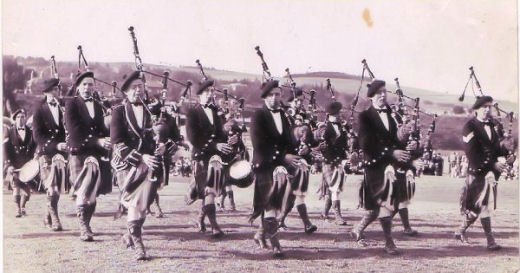
That day there were 17 bands in Grade 1, and 43 bands in total in all categories. It was a day savoured by all the Bandsmen. P/M Hepburn described as “one of the best day’s enjoyment he had ever had” and he spoke for the whole Band when he commended the excellent arrangements made for the welfare of all Bandsmen and their friends. The Vale public was equally enthusiastic – it was not only a first for the Band, it was a post-war first for the Vale for one of its own to win a national title.
On Sunday 13th June, the day after winning the Scottish Championship, the Band paraded on more poignant duty back in the Vale. Accompanied by Renton Pipe Band, it led the parade to the Christie Park for the British Legion’s drumhead service. At the service the dedication took place of the Memorial Plaque on the Bass Drum to Piper Lachlan Brown and Drummer Duncan Frazer, the two Band members who had died on active service in the war.
A few days later the Band received a letter from Mr Whitelaw, Secretary of the SPBA congratulating the Band not just on their achievement of winning, but also in their performance which he believed had raised the standard – “progress of Pipe Band Culture is now a reality”. He probably wrote every year to congratulate the winner of the Scottish Championships, but his letter goes beyond the normal civilities associated with his post and it was quite a compliment to the whole organisation of the Band. He also singled out the P/M’s keenness and ability and finished by again congratulating the Band, the Committee “not forgetting your women supporters”. It was further proof of the very high regard in which the Band was held by the SPBA and the pipe band community as a whole.
In August 1948 Band decided not to enter Cowal (or Milngavie) because of a shortage of pipers on these dates. Whether that was the real reason or not is another matter since a discussion took place in the Committee about the Cowal Question, but no details were minuted. The band did enter the World Championships at Scotstoun Showground on 14th September, which of course was being run by the SPBA.
1948 World Championship Program list of bands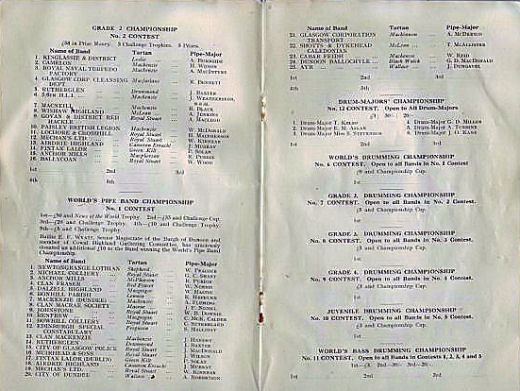
1948 World Championship program order of events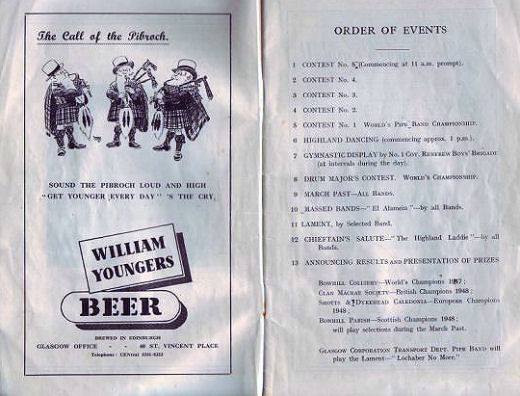
This was the first time all season that the band could provide a full muster for a contest, so it’s a fair guess that hopes were high for a victory. It also strongly suggests that BPPB sided with the SPBA on the Cowal question at this stage, and further evidence of that came to light at the 1948 AGM. There is no further reference to the World Championships in the minutes, but much time was devoted to the Flag Day, in support of which the Band paraded in each locality throughout the Vale. That silence is a pretty good indication of the disappointment at not being placed in the Worlds.
Band parading on what looks like the Ritchie Hill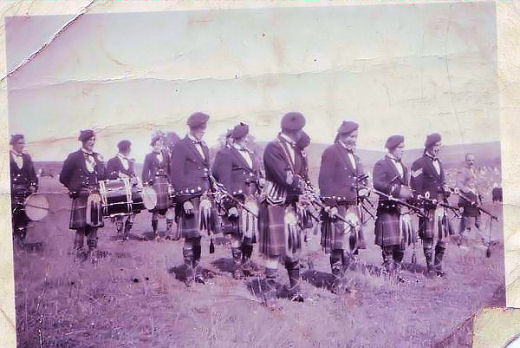
Cochrane & Co
Although 1948 was a very successful year competitively for the Band, trouble was brewing amongst some of the younger Band members and it came out into the open for the first time at the AGM in October. A group of the younger members led by Charlie Cochrane had been meeting outside of Band practice sessions to practice on their own, and this had created a “band within a band”. The clear impression was that this group was preparing to break away and form its own Band, and indeed Charlie Cochrane said that he wanted to form his own band, but not register it with SPBA “this year”. He also said that he would bring additional pipers to BPPB and did not want to undermine Bonhill.
The Band’s management dubbed the group “Cochrane & Co” and was deeply suspicious of what it regarded a disruptive element within the Band. The younger members were mostly in their teens, had joined the Band after the war and were doing what teenagers do, rebelling against authority and finding their own way, which was pretty well what many of the older members had done when they formed the Band in 1931.By and large they were also very talented musicians.
There was an inevitability about the whole affair as mutual discontent within the Band grew. A further concern was that P/M Hepburn was emigrating to Australia in July 1949 and it was felt that the matter should not be left to a new P/M who would have enough on his hands settling into a new role. In January 1949 a meeting of the full Band agreed that Piper Cochrane should tender his resignation and that other like-minded members should either commit all their time to BPPB, or tender their resignations.
With Charlie Cochrane already gone, on 17th February 1949 a further 6 resignations were received from: Pipers J Finlay, W Ronald, Bruce Rennie, Archie Rennie, T Smith and Drummer Alex Miller. The resignations were accepted unanimously and the former members were told to return their kits, which they duly did.
The Lennox Pipe Band
The departed members did indeed form their own Band, The Lennox Pipe Band, which based itself in Dumbarton. It registered with the SPBA and played in many competitions in its short life (it only lasted until December 1950). The talent of these young musicians is evident in the success that the new band had in its 2 seasons of competing. Although not yet a Grade 1 Band, at lower grades it won a number of prizes at such events as Cowal and the World Championships. Over 40 years later, writing in the Dumbarton and Vale of Leven Reporter, Alex Miller recalled the happy days and great times he had with the Lennox Pipe Band.
Photo 23 – Lennox Pipe Band
He named some of his colleagues in the Lennox Band – Charlie Cochrane and his brother Harry, Jazza Raeside, Archie Rennie, Jim Montague, and Marty Hainey. The harsh economic reality of running a Pipe Band caught up with the Band in its second season. It didn’t have the back-room support such as the Ladies Committee and the non-playing officials, nor the generosity of the Vale public to help it out. The demise of the talented Lennox Pipe Band is ample proof of how important that support was to BPPB. The Band folded in late 1950.
Back on Board
In December 1950 eight of its former members joined, or in some cases rejoined, Bonhill Parish. They were Pipers Charlie Cochrane, Harry Cochrane, Marty Hainey, Smith, Connell, James Montague and Drummer Raeside. Archie and Bruce Rennie and Alex Miller rejoined soon afterwards. Some of them went on to play in the Cowal winning Band nearly 2 years later, while others such as Charlie Cochrane eventually went on to very successful careers with other bands. Charlie played for years with the British Caledonian Airways Pipe Band which took him around the world and stayed with it when it became Scottish Power Pipe Band after British Airways took over BCal.
A New Pipe Major
The Cochrane & Co affair brought forward a decision about a new Pipe Major to succeed Dickie Hepburn, who was going to Australia in the summer of 1949. In January Dickie himself proposed Jimmy Jackson as his successor, and Jimmy was unanimously appointed deputy P/M, effective immediately, taking over full control when Dickie Hepburn departed. It was a seamless transition and, of course, it was a role which Jimmy had held during the years when he deputised for Dickie, as Acting Pipe Major.
The next major issue which concerned the Band was the wish of Drummer McDougall to join it, which was first raised in the spring of 1949. The matter was treated with great care because he had previously been a member of Renton Pipe Band and it was refusing to release his registration, although he had already resigned from that Band in November 1948. Doubtless the Renton Band had its reasons, and Bonhill Pipe Band was very keen to avoid alienating Renton with any hint of poaching, so the case was referred to the SPBA.
William McLean himself attended a Committee Meeting in June 1949 to report on the SPBA executive’s findings, which were entirely in favour of Bonhill. The SPBA was particularly complimentary about the way the BPPB Secretary, AB MacGuire, had handled matters and it is notable that the competence and energy of AB MacGuire is a recurring theme at this time. At that same meeting Jimmy Jackson formally took over from Dick Hepburn as P/M.
In spite of losing so many members in February of 1949, the Band performed reasonably well that season. It finished the season by returning to Cowal in August – back for the first time since the SPBA versus Cowal dispute arose in 1947. By 1949 peace had been restored and all bands were attending Cowal again. Bonhill Parish was pleased with its 4th prize – which was the Glenfinart Challenge Trophy and £20.
During the winter of 1949 – 50 there were further changes to the playing personnel as Bass Drummer McLean’s other activities meant that he couldn’t devote the necessary time to playing with Band, and drummer Phil Good also resigned. Joining was drummer Dougie Wallace.
The 1950’s
1950 proved to be a busy year with a steady stream of contests and other engagements – in fact it was so busy that it had to turn down as many engagements as it took on. Its competition roster and transport arrangements to get to them were as follows:
- 13th May – Edinburgh 2 buses
- 20th May – Kilsyth 1 bus
- 10th June – Markinch 1 bus
- 17th June – Renfrew Train
- 24th June – World Championships, Dundee 2 buses
- 22nd July - Helensburgh Train
- 5th August – Inverkeithing 1 bus
- 19th August – Rothesay Steamer
- 26th August – Cowal 2 buses
The SMT provided buses for Dundee and Cowal, McAteers of Dumbarton were used for all the rest.
Band parading in competition: note the judge on the far
side of the front row of the Band and the crowds
However, there were few prizes from contests in 1950, and the general feeling was that it had been an “unlucky” year. There seems to have been a problem with turning out enough pipers for contests and engagements, and whether this was largely down to short notice as some pipers complained, or a dip in morale and motivation it is hard to say.
In any event vigorous steps were taken to try to rectify the situation and by the autumn of 1950 there was such an influx of boy pipers needing tuition that P/M Jackson suggested that he temporarily change positions with Pipe Sergeant Hugh Smith so that he could concentrate on tutoring the younger pipers throughout the winter. Such were the improvements, boosted of course by the members joining from the now-disbanded Lennox Pipe Band, that by February 1951 Jimmy was able to resume his position of P/M.
One of the first decisions that Jimmy made in February 1951 was the sets of tunes which the Band would play in the upcoming contest season. This is the only copy of sets which has survived, and its further significance is that 3 of the tunes were those played by the Band the following year at Cowal when it won the Cowal Championship – the Abercairney Highlanders, Bogan Lochan and Pretty Marion. The full list of the 1951 sets is as follows:
Marches
- Balmoral Highlanders
- Abercairney
- Blackmount Forrest
Strathspeys
- Shepherd’s Crook
- Bogan Lochan
- Cameronian Rant
Reels
- John MacKechnie
- Mrs McPherson
- Pretty Marion
Massed Pipes & Drums
Although the Band did not enter many competitions in 1951, it did enter the World Championships and the Cowal Championships and there are a couple of interesting snippets in that year from these two leading competitions which show how the Pipe Band world was trying to make Pipe Band competitions more attractive to the public at large. Firstly, at the World Championships which were again held in Edinburgh during the Festival, the SPBA insisted that all Grade 1 Bands participate in a Mass Band Parade from Parliament Square at 1pm and march en masse down the Mound and east along Princess Street to Meadowbank, where the competition was held.
This was the first time that the march of 1,000 Pipers had been held anywhere in the world. Bonhill Parish was part of this first 1,000 Pipers parade, which is shown in the photograph below. It was taken as the mass bands pass the National Galleries at the bottom of the Mound and swing east on Princess Street. The bands were inter-mixed with pipers marching with pipers, side drummers with side drummers, and bass drummers with bass drummers. The Bonhill pipers are in the right hand row and start just about in line with the lighting standard in the right-hand foreground.
Pipe Sergeant Donald McDermid is the most visible, with Pipe Major Jimmy Jackson just in front of him. As can be seen from the crowds massing the pavements, the SPBA were quite right in thinking that this would be a crowd pleaser. There is also a clip of the massed bands and of the band playing at Meadowbank in Part Two of Colin Liddell’s Lovely Valley videos, although that probably dates from 1953.
Massed Bands in Princess Street probably 1951
A week after this first 1,000 Pipers parade, the Cowal organisers followed suit and insisted every participating Band must parade from Castle Gardens to the Games Field in Dunoon, thus introducing what is now a Cowal trade-mark feature, the massed pipe bands. Cowal varied it a bit with each band marching separately and asked that each Band must have its name prominently displayed.
Although most people think that the band’s name will be on the skins of the bass drum, many did not display them there – Bonhill Parish, for instance, did not. The Cowal organisers wanted an Olympic-style parade with the names carried on a placard in front of each Band. This was without doubt something which pleased the public, and made it easier for them to relate to the pipe bands. Bonhill Parish took part in these first two steps towards a more modern crowd-friendly piping world.
Local Engagements
The Band remained in great demand for a wide variety of other playing engagements in the locality and even a cursory list shows how popular it was. They also throw some light on long forgotten aspects of the times. Local parades included...
- Playing at the Cattle-show in the Hospital Field, Alexandria, which was a long-standing engagement.
Smaller Band group at the Cattle show
- The Bandsmen in this group are (left to right): Jim Fee (at the back), Archie Rennie (in the foreground), Bob Ritchie on the Bass Drum, Willie Ronald, Jimmy Jackson, only partly visible.
Photo 27 Larger Band group at the Cattle Show
- Again left to right: Donald McDermid, Jim Kinloch at the back, Hugh Smith, Jimmy Kelso at the front, Drummer Dougie Wallace, Piper Jim McFarlane, Jim Fee at back, then Archie Rennie, and Jimmy Jackson at front right hand side.
Band in a circle round D/M Kelso at Cattle Show.
- Leading Clydebank Labour Party’s May Day Parade from the Boulevard, down Kilbowie Road to the local park. Elliott’s bus took the Band to that engagemen
- A church parade for Renton Girls Guildry, which appears on video in The Lovely Valley.
- Leading a church parade to commemorate the Battle of St Valery in 1940. Although largely forgotten now, St Valery was still a real enough issue in 1950. Two weeks after the end of the evacuation at Dunkirk, the 51st Highland Division was still fighting in northern France. It had been used as a sacrificial lamb, being left to fight and draw the Germans away from Dunkirk for as long as possible, with its back against the Channel and no Dunkirk-type evacuation possible. Battalions of most Highland regiments were involved and many local men had been serving in them. The soldiers who had to surrender then spent 5 years in German POW camps, most emerging with some bitterness about the whole experience, so this parade had a special local significance, not to say edge. There was never the slightest likelihood that the Band would not have played at it.
- Playing at the Co-op Children’s Day in the Boll o Meal Park.
- P/M Jimmy Jackson accompanying the British Legion’s War Orphaned Children’s summer trip, as Jimmy did for many years.
- Playing at a Youth service event at Millburn.
- Playing at Council-sponsored engagements at the Christie Park, Dalmonach, Cordale, and the inaugural Balloch Illuminations (the following year the Band declined to play at the Illuminations on the Sabbath because that would be “contrary to the customs of piping” – another date was arranged.)
- Accompanying an Old Folks outing on a steamer trip up the Loch
Band on Balloch pier as senior citizens outing boards the steamer.
- Note the typical wet summer’s day. The minister in the mid foreground at the end of a gang-plank is the Reverend Winthrop from Renton, while the couple at the back of the photo standing beside the railway wagon are Drummer Dougie Wallace’s parents.
At some of these events the Band was more than happy to provide its services for free, while some others (the obvious ones) were a very useful source of revenue, with a typical fee for an appearance being about £10. This income was in addition to the continuing fund raising activities of the Ladies Committee, as well as the money raised by the Flag Day, Draws etc. An unexpected, and unfortunately unexplained, financial bonus arrived in April 1951 when the Band received a cheque for payment for war damage to Band property “during hostilities”. We’d love to know what this was all about, but there is no mention of what property was involved or when, how and what damage was done, so the mystery remains.
A couple of significant changes in the Band’s line-up took place in October 1951 when Leading Drummer McDougall was called up for National Service and he was replaced as Drum Sergeant by Alex Miller. Both of these drummers were very young - it was only 2 years previously that Drummer McDougall was being described as a “minor” when he was seeking his release from Renton Band – while Alex had not yet been on National Service and wouldn’t go for another year or so. At the same time, Donald McDermid who by comparison with the two drummers was both a military and a Band veteran, became Pipe Sergeant, a position he held for many years.
Glory Days - Cowal and Hampden
Saturday 30th August 1952 was the most successful day in the Band’s existence. On that day they created not only their own history, but a piece of Cowal Gathering history as well. Bonhill Parish Pipe Band won the Cowal Pipe Band Championship and a youthful Drum Sergeant Alex Miller went on to win the Cowal Championship as well – the very first time that any Band had won both of these Championships at the same Gathering.
Most clubs, teams and organisations talk up their achievements no matter how mediocre they are or were – along the lines of “the older we get the better we were”. It’s a very curious aspect of Bonhill Parish Pipe Band that the Bandsmen who actually won the Cowal Championship, undoubtedly an outstanding achievement with a lifetime of bragging rights in piping circles and the community at large, all seem to have talked it down, both at the time and since.
It is not as if most of them were or are shy and retiring – most were very strong characters indeed, well used to standing up for themselves. It would seem that they were genuinely quite surprised to have won on the day. Although each had different reasons to explain their success – one saying that the bands which played before and after them had an off day which made Bonhill sound better than the Bandsmen felt that it was, while others say that Bonhill was a very popular band, a bit of a crowd’s and judges favourite (the judges are in a closed tent and not supposed to know which band they are listening to, so that shouldn’t have been a factor).
The fact that they were quite simply the best on the day only seems to have occurred to them and been accepted by them quite slowly. To their supporters and other spectators, there was, of course, no doubt which was the best band, and Bonhill’s victory was an extremely popular one in the Cowal arena.
On top of all that, Drum Major Jimmy Kelso only missed out on the Pipe Major’s Championship by half a point to a former Scots Guard sergeant. To his dying day, Jimmy vehemently maintained that the Scots Guard had only won because his moustache was slightly straighter than Jimmy’s. Spare a thought too for Piper Scott Williamson, who was doing his National Service down at York and had travelled up every week-end that he got leave to play with the Band, but was not given leave to be at Cowal. His father phoned him with the news of the Band’s win, and his was the first letter of congratulations received by Jimmy Jackson (there were many).
So the Cowal Gathering Field at Dunoon on that Saturday in August 1952 was a very happy place to be for Bonhill Parish Pipe Band and its supporters. The best account of the win is given by the Lennox Herald the following Saturday and it is given in full below as it was printed. The Vale District Council invited the band to play in the Christie Park on the afternoon of Saturday 6th September from 2 pm until 5 pm and thereafter attend a civic reception in their honour – the first time the Council had given a Civic Reception to anyone. The Lennox also carried a full account of the Civic Reception and a transcription of that is also given, since it supplies a lot of background information as well as conveying the pleasure the win gave to the whole of the Vale. The Cowal Shield and Drumming Trophy were displayed in the Gas Show-Rooms window in Main Street Alexandria, and then they also went on display in the window of the Co-op Dairy in Bonhill.
Surprisingly, there is no photograph of the Band playing at Cowal that day, or being awarded the trophies, not even a “team photo” of the Bandsmen beside the bus, or back in the Vale or anywhere else that day (there are photos of the Band playing in Gilmour Street at 1 in the morning, but only a few members, plus the bass drum, can be glimpsed through the crowd). That seems an astonishing omission to-day on the part of the Cowal organisers, who needed a photo of the Champions each year for the following year’s program. The Band itself wasn’t really any better, because it was only when Cowal asked for a photo in the spring of 1953, that it got round to having one taken.
The “team photo” of the winning band was taken in the playground of Main Street School on Saturday 13th March in 1953; a mere 6 months after the Band won it. That says something for the modesty or nonchalance of the members. In fact the photo is not 100% accurate since drummer J McKenzie is missing from it.
Cowal “Team Photo” the Cowal Champions including the Committee.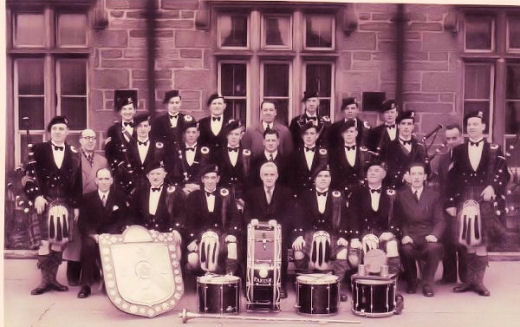
The people in the photo are as follows:
Back Row, left to right:1. Alex Miller (Alexandria) 2. Dougie Wallace (Bonhill) 3. Robert MacKinlay (Bonhill), 4. Neil Smith (Jamestown) 5. Jimmy Kelso (Renton) 6. John Simpson (Clydebank) 7. Sam Gibson (Dumbarton).
Middle Row, left to right: 1. Jimmy Jackson (Bonhill) 2. AB MacGuire (Alexandria) 3. Danny Williamson (Dumbarton) 4. Tommy Hardie (Renton) 5. James Montague (Dumbarton) 6. R Fraser (Renton) 7. Jim Fee (Dumbarton) 8. Bruce Rennie (Renton) 9. Scott Williamson (Dumbarton) 10. Tommy Smith (Alexandria) 11. Donald McDermid (Alexandria)
Front Row, left to right
1. Alex McEwan (Bonhill) 2. Donald Brown (Clydebank) 3. Hugh Smith (Jamestown) 4. John Rogers (Alexandria) 5. Jimmy McFarlane (Alexandria) 6. Jackie McIntyre (Cardross) 7. D Mills (Renton).
Not in the photograph is Tenor Drummer J McKenzie.
Cowal Team Photo” without the Committee but with the Argyll Shield
This photo was taken immediately after the one including the Committee members, but includes the Cowal Pipe Band Championship trophy, The Argyll Shield. Also clearly visible at the top of the Bass Drum rim is the Presentation Dirk which the Band won for its immaculate appearance. The line up for this photo (all rows left to right) is:
Back Row: Alex Miller, Dougie Wallace, Bob McKinlay, John Simpson, Sam Gibson
Middle Row: ? Williamson (Scott’s Brother), Tommy Hardie, Jimmy Montague, Jim Fee, John Robert Rennie, Scott Williamson.
Front Row: Jimmy Jackson, Donald Brown, Hugh Smith, Jimmy Kelso, Jimmy McFarlane, Jack McIntyre, Donald McDermid.
The report of the Cowal victory as carried on the front page of the Lennox Herald of “Saturday Morning” 6th September is given here as it was printed:
“Bonhill Parish Pipe Band scored a unique triumph at Cowal Games on Saturday, by winning the Pipe Band Championship and the Drumming Championship.
The Band, with only nine pipers available, left the Vale looking very smart in their red Lennox tartan kilts and blue tunic, in the hope that they would at least gain a place.
Neither the present World Champions (Shotts and Dykehead Caledonia) nor ex Champions (Glasgow City Police) was placed.
Clan MacRae gained second place; Red Hackle third; Finton Lalor, from Dublin, fourth and Renfrew fifth. With the Championship goes the Argyll Shield Challenge Trophy; the Peter Ferguson Trophy and £50.
For 20 year old Alex Miller, Drum Sergeant of the Band, it was a great day. It was his solo drumming which caught the judge’s eye and gained for him the Cowal Drumming Championship, and with it the Douglas Challenge Trophy and £14.
Pipe Major Jackson said “the Band never put up a better performance. It was a great day for all of us”.
The fourteen members of the Band at Cowal on Saturday were as follows...
- Pipe Major JR Jackson
- Pipe Sgt D McDermid
- Pipers H Smith, J McIntyre, J McFarlane, D Brown, J Montague, J Fee, A Rennie
- Drum Sgt A Miller, Drummer D Wallace, Drummer J Simpson, Tenor Drummer J McKenzie, Bass Drummer R MacKinlay.
The tunes played in the Championship competition were Abercairney Highlanders, Bogan Lochan and Pretty Marion.
Cowal Band, no committee but the trophies are identified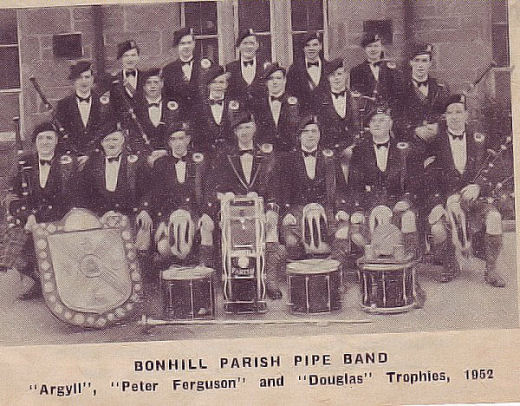
A crowd of well over a thousand people waited over 2 hours at Alexandria Fountain to give the band a “welcome home”. It was well after midnight when the two specially chartered buses halted at North Main Street where the band got out, tuned up and marched to the Fountain and into Gilmour Street where Mr John Rogers (74-year old President of the Band) addressed the crowd. He said “this is a great day for the Vale. I have waited 21 years for the Argyll Shield. We have won all the other competitions and now it is ahead to the World Championship.”
Crowds in Gilmour Street with Band at 1 o’clock in the morning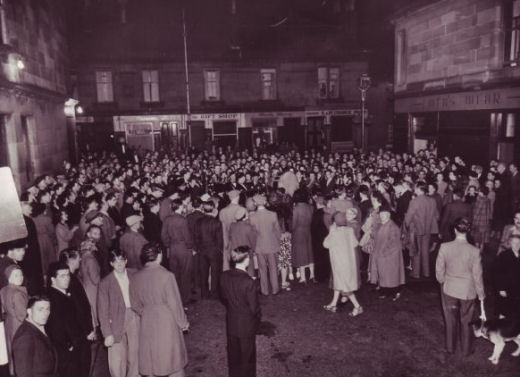
Jim Walker, a resident of Gilmour Street, hung up a couple of electric lights from his windows which helped to make the ceremony very pleasant. The band discoursed music in the street until nearly one o’clock on Sunday morning.
It was 21 years ago last month that Bonhill Parish Pipe Band was formed. Mr John Rogers, who was elected President on its formation, has held that position ever since. Pipe Major Jackson and Piper Hugh Smith are the only original playing members. Mr Neil Smith, a committee member, has also been with them 21 years.
Crowds in Gilmour Street complete with Jim Walker’s lights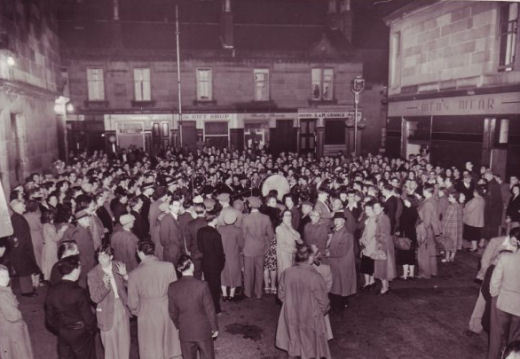
The following are extracts from a front page report in the Lennox Herald of Saturday 13th September of the Civic Reception given to the Band by the Vale of Leven District Council in the Council Offices in the Ewing Gilmour Institute in Gilmour Street.
“A Civic Reception was held on Saturday 6th September for Band members in the Reading Room of the Council Offices. Mr Archie Baxter (vice-chairman of the Council) was in the chair in the unavoidable absence of Mr Skinner (chairman of the District Council) who sent his apologies. About 60 guests sat down to dinner.”
Mr Baxter offered his welcome and congratulations and noted that Mr Rogers had been on the Council at one time and he knew that he would be able to blow hard for Bonhill Parish Pipe Band.
Councillor John (Jock) Wilkie proposed the toast to the Band, (and made a perhaps surprisingly good job of it too). He started by saying that the 96 points scored by the band was highest that they had ever achieved in competition. In spite of Cowal’s troubles with the SPBA some years ago, Cowal was still considered the unofficial championship.
Great credit was due to Pipe Major Jackson, Drum Major Kelso and Drum Sergeant Miller. He was sure that Pipe Major Hepburn would hear the news in Australia with as much pride as everyone in the Vale. The band had won the Scottish and British Championships over the years and the young members of the band now had a very high standard to maintain. Mr Wilkie concluded by saying that he had at one time been on the band’s committee, and had stood in as temporary Secretary for a short time. He therefore wanted to mention the back room boys and girls and thank them too for their achievements.
John Rogers made the first reply for the Band. He told in his own words the story of the formation of the Band. “21 years ago last month, two boys came to see me in my workshop in Campbell Street, Bonhill, and asked me to attend a meeting in the Conservative Club Rooms. When I asked them what it was about, I was told “never mind, you’ll find out when you get there.” These two boys were P/M Dick Hepburn and Leading Drummer John McLachlan. When I got to the Conservative Club Rooms, I found out that I was in the middle of a Pipe Band. I said that I would be their President if they promised to go to Cowal within three years. We went to Cowal in our 3rd year and won the Harry Lauder Shield, the Scottish Shield and the second grade championship.”
Miss Miller Weir, the Band’s Honorary President spoke, saying that she attended the Reception in spite of her doctor’s orders not to. This was one of the happiest and proudest days of her life and nothing would have kept her away. Other members of the Band spoke – P/M Jackson, D/M Kelso and D/S Miller – as well as Honorary Vice President Major Leckie Ewing. (The Major lived on Cameron Estate for a number of years and was very highly thought of by everyone who knew him – his wife perhaps more so since she had caught the largest salmon ever landed on the fly on Loch Lomond.) The Major was a leading authority on piping, who had helped the Band on many occasions, including judging at some of its competitions in the Co-Operative Hall in the 1930’s, and he said that the Band had achieved a very high standard indeed.
What Kept Them?
One of the questions about Cowal that people asked later was “where were they until 1 o’clock in the morning?” The most obvious answer is, of course, that they were all members of a pipe band, so where do you think they were until 1 o’clock in the morning?” And you would be quite right with your own likely answer. The journey back from Cowal got no further than the Creggan Inn at Strachur on the shores of Loch Fyne when the bandsmen decided to stop at this roadside hostelry to start their celebrations.
After a few drinks some of the supporters buses left and got back to the Vale at what probably seemed a reasonable hour. The bandsmen, however, were not for moving. When the others got back to the Vale they were surprised at the crowd which had gathered to greet the returning (or not-yet-returning) heroes and phoned the hotel where the bandsmen were happily esconced – many times apparently - to try to encourage their departure. In scenes straight from Para Handy, with Sunny Jim trying to coax Para, Dougie and Dan MacPhail out of the pub because of the imminent arrival of a cargo owner, or worse still, a Broad of Trade inspector, it seemed that the more that they were asked to get back on the bus, the more they drank. Eventually they gave in and got back to the Vale about 1 am, but none of the crowd was particularly bothered about the long wait.
The Band’s trips into Argyll and Bute featured many interesting distractions after the war. In the late 1940’s it was invited to play at Inverary as a replacement for a certain Glasgow-based Grade 1 band which had partaken too much of the demon drink the previous year. Suffice to say that after a single appearance, the Bonhill Parish wasn’t invited back either.
Sometimes the Band left a sort of paper trail about where it had been – like the letter from Sandbank Police Station in March 1959 telling the Band to come and pick up a drum which had been handed in to that Station on 31st August 1958 and had lain unclaimed for 6 months. Sandbank is the very first village out of Dunoon on the way home to the Vale; it’s just a couple of miles from the Games field and even now has two hostelries. On the Games day, they would have been a bit quieter than the packed pubs of Dunoon and probably deemed a safer bet than a return to Creggans. But on the road back from Cowal if it wasn’t one thing it was another. Flies would have paid to be on the wall when the excuses about how that drum came to be “mislaid” were being trotted out.
And not only drums were left behind after contests. A piper, who shall remain nameless, left not only his wife, but also her sister, standing on Rothesay pier, completely forgotten about, as he sailed away to Craigendoran with other Band members after competing at Rothesay Highland Games. Mind you, he’s not been allowed to forget it ever since. In the pipe band community there’s no doubt at all which of the two is the greater sin. Forgetting the wife is very regrettable no doubt and really is not recommended, but forgetting a set of pipes or a drum – now that is a heinous crime.
The Road to Hampden
If 1952 was a great year for the Band, 1953 was an even better one for the whole Vale – the Vale of Leven FC won the Scottish Junior Cup for the first and, so far, only time in its history. It couldn’t have happened at a better time because the whole of the Vale was decked out with flags, bunting and illuminations to celebrate the Queen’s Coronation 2 weeks later. And of course Bonhill Parish Pipe Band was still the Cowal Champion Band.
It was the perfect back-drop for the team’s victory homecoming parade along Renton and Alexandria Main Streets to the Fountain and into Gilmour Street. The team bus was led right into Gilmour Street through crowded streets by the two local Pipe Bands – Renton and Bonhill Parish. They could just about squeeze through and for many in the crowd the clearest view they got of anything was the Band maces as the Drum Majors threw them high in the air. It was a great atmosphere and is captured on a Lovely Valley video. It was only right and proper that the Bonhill Parish Pipe Band should lead the victorious team home, because it had been something of a lucky charm for the Vale Juniors that year. The Band had played at all of the Vale’s home cup ties that season, which were played before increasingly large crowds.
Of course, parading at Millburn before these games and at half-time was the perfect opportunity to once again show off the Cowal Championship trophies from the year before, as well as take up a collection. This was still being done in the time-honoured fashion of walking round the track, usually after the Band, with 4 people each holding a corner of a sheet into which the spectators threw coins. This could be a pretty hazardous experience and more than one collector was hit by a misdirected coin, although none seriously. These days the Health & Safety police would have a field day.
The Band also wanted to play at the semi-final at Ibrox against the Glasgow club Ashfield, on the evening of Saturday May 2nd 1953. Incredible as it seems now, no one on the staff at Ibrox, other than the legendary manager Mr Bill Struth in person, could give permission, and the Band was told to write to him. Permission was duly given and the Band paraded before the game, and at half-time. The Vale ran out comfortable 3-0 winners against Ashfield, who were the favourites for the Cup that year and had brought a huge Glasgow following into Ibrox that Saturday evening.
Jimmy Jackson and Bandsman with man with rosette in the background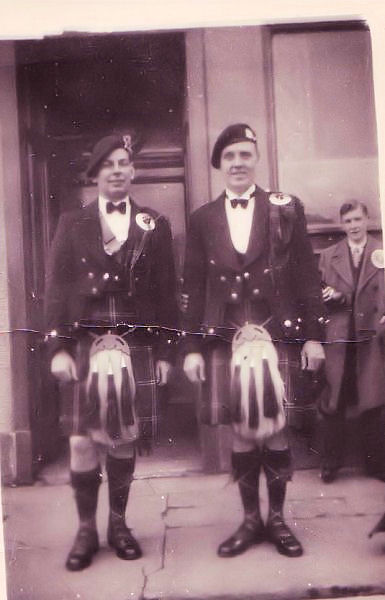
The Band’s appearance at Ibrox had some comic aspects of which the large crowd was unaware. Firstly, the Band was missing its Leading Side-Drummer, Alex Miller, and was unable to get a side-drummer replacement at short notice. Piper Sam Gibson was chosen as a ghost side-drum replacement with strict instructions that under no circumstances was he actually to put a drum stick onto the drum skin. Never mind that Sam couldn’t play the drums, he had never even carried one any distance before. Which brings us to the second comic turn.
For reasons best known to himself, Pipe Major Jimmy Jackson set off round the track at a cracking pace, forcing Drum Major Jimmy Kelso to up his speed too. A gap started to emerge, but the pipers closed it up quickly enough. However, it was a different story at the back of the Band with the drummers. For Sam Gibson, carrying off the drum charade would be a difficult enough job at the Band’s usual marching pace; at the greyhound speed being set up front it was just not possible. As Drummer Dougie Wallace says “we nearly had to nick across the halfway line to catch up with the rest of the Band”.
As is the way of these things, no one except the Band seems to have noticed, and normality was restored by the time the Band paraded at the final at Hampden a couple of weeks later.
Saturday May 23rd 1953 the Vale played in the Scottish Junior Cup final against Annbank United from Ayrshire. At 56,000 the Cup Final was the largest crowd which the Band had played for, and obviously they were totally fired up for the occasion, with a real belief that as Cowal Champions they would do the Vale and the whole crowd proud. As usual the Band was immaculate in appearance and had the swagger of Champions as they marched round the track to the cheers of the large Vale support. For many years it was the boast of many of the bandsmen that they had played at Hampden– and there was more than hint of seriousness in the joke. It seemed to work as the Vale beat Annbank 1-0 thanks to a Willie Cassidy goal. God was in his heaven: the Vale had two champions and the glory days were here.
The Band marching at Hampden
We don’t now the full line-up of the Band at Hampden, but thanks to contributions to the Reporter in 1992 from Piper Archie Rennie and Drummer Dougie Wallace’s recent contributions to this story, we know that it included Pipe Major Jimmy Jackson, Drum Major Jimmy Kelso, Bruce Rennie, John Robert Rennie, Hughie Smith, Jimmy McFarlane, Donald McDermid, Jackie McIntyre, Jim Montague, Dougie Wallace, and Donald Brown.
Identifiable in the photo are:
Leading the Band: Drum Major Jimmy Kelso.
Front Row of Pipers (left to right): Pipe Major Jimmy Jackson, Hugh Smith, Jimmy McFarlane, Bruce Rennie, and Pipe Sergeant Donald McDermid
Second Row (left to right): Donald Brown, don’t know, d/k, Jackie McIntyre
Third Row (left to right): d/k, Sam Sibson, d/k, d/k
Back Row: the only drummer who can be seen is Dougie Wallace on the extreme right at the back of the Band
As the victorious Vale football team returned to the Vale, the celebrations really got under way. Large crowds had taken to the streets of both Renton and Alexandria to greet the returning heroes. As the team bus came into Renton, Renton Pipe Band was waiting to lead it through the crowded streets at the start of its victory parade through the Vale. Led by Pipe Major George McLean, Renton Pipe band did the honours, leading the procession in front of the bus which was crawling through the cheering crowds, with the footballers holding the Cup aloft on the roof of the team bus.
Etiquette dictated that it should be so, but there was an additional reason which only adds to what a great occasion it was for the whole Vale. The Vale’s captain was Chummy Gilmour and Chummy was married to a Renton girl, May Woods. May’s family were office-bearers in Renton Pipe Band and nothing could be more appropriate than that Chummy’s relations’ Band should have the honour of leading the team back into the Vale and right through Renton.
As the procession came into Main Street Alexandria, Bonhill Parish took up the leading position, with Renton Pipe Band immediately behind them, just in front of the bus. This was the order as the bus proceeded to the Fountain and to the Council Offices in Gilmour Street, where an official welcome awaited them. However, the crowds were so thick that it is doubtful if many people saw the Bands, the most they would see were the maces as Jimmy Kelso and George McLean threw them high in the air. But nobody, least of all the Bandsmen, cared. The Vale had won and that was all that mattered.
The Band parades at Millburn as the Scottish Junior Cup is displayed
Naturally enough, the Vale paraded the Cup at Millburn on the opening day of season 1953-54 and there, to support the Cup on its journey round a packed Millburn, was the Band.
Final Years
Although the years after 1952 and 1953 may seem like something of an anti-climax in retrospect, the Band continued as one of the top Grade 1 Bands in the country for some years yet. True, there were personnel changes with pipers and drummers coming and going, but then there always was a pretty steady flow of Bandsmen in and out of the Band. Some of the back-room boys departed too. President Jock Rogers retired in 1953 having held the job for 22 years, from the evening the Band was founded. He was now 75 years old and he had achieved a life’s ambition with the Band winning Cowal. Jock became the Band’s Honorary President, and the Vice President Alex McEwan, husband of Mrs McEwan, chairwoman of the Ladies Committee stepped up to the Presidency. Alex stayed on until the Band’s demise.
Bandsmen playing at Jock Rogers’ funeral with John Glen’s new hearse in the background
In 1958 another long-time Band stalwart, Treasurer Neil Smith, died. Neil had been involved with the Band from the very beginning and apart from years in the RAF during the war had been either Secretary or Treasurer since 1933.
Season 1958 is the last for which a roll-call of the Bandsmen survives, in the form of the list of pipers and drummers registered with the SPBA for 1958. While it shows some changes, it also shows that 8 of the Cowal winners were still present and playing with the Band for that season.
The list of 17 Bandsmen for 1958 was:
Pipers: P/M Jimmy Jackson, Senior (Balloch), John McIntyre (Cardross), Jimmy Jackson, Junior (Balloch), James McFarlane (Tullichewan), Archie Rennie (Dumbarton), James Montague (Dumbarton), P/S Donald McDermid (Balloch), Hugh Smith (Alexandria), John Love (Dumbarton), James Kinloch (Alexandria), James Fee (Dumbarton)
Drummers: D/S Alex Miller (Alexandria), Bass Drummer Robert Ritchie (Balloch), John Duncan (Alexandria), Gordon Badger (Dumbarton), Alex McKean (Dumbarton), Robert Chisholm (Knightswood, Glasgow).
The Band’s engagements, both competitively and locally, continued at its usual hectic level until the early 1960’s. The departure of another stalwart and Band founder, Pipe Major Jimmy Jackson, who emigrated to Australia in 1959, was a big loss but a good core of Bandsmen remained after that. In fact the late 1950’s saw something of an influx of young pipers who had to be trained up by the Band. However, there were signs of decline and by the mid 1960’s the Band had to all intents and purposes stopped functioning.
There was no single reason for the Band’s decline – no fall-out or walk-out, no lack of funds, no decline in Pipe Bands generally. Bandsmen just drifted away – some to do other things apart from piping, some to join other bands, some to leave the area altogether. Looking back, none of the remaining members think of the Band with anything but great pleasure and affection. They remember their colleagues as friends and have happy memories of the time spent with them. But time moves on.
Although the Band had stopped playing, the organisation held on for many years. However, by 1979 it had been clear for some time that there was no hope of a revival and the remaining members decided to formally disband. The Treasurer, Mrs Elizabeth Smith, widow of Neil, sent the remaining funds of £300.62 to Erskine Hospital. Bonhill Parish Pipe Band was no more.
Postscript
Other Bands emerged in the area and two other Pipe Bands are still playing and competing to-day, producing many fine musicians along the way. Also, individual pipers from the Vale are to be found in bands up and down the country. In 1969 Dumbarton & District Pipe Band was formed, with Jimmy Jackson Junior as its first Pipe Major. It first met and practiced at the Brock Bowling Club in Dumbarton. In 1975 Gordon Lawrie took over as Pipe Major, and although he no longer plays he is still very much involved in the Pipe Band scene. The Band is very active and is now based in Station Street Renton where it has its own hall.
Helensburgh & District Pipe Band has also survived and continues to flourish, attracting members from the Vale. Pipe Bands and piping generally have never been more popular. The World Championships at Glasgow Green in 2009 attracted more than 8,000 pipers and drummers and 40,000 spectators from 16 nations around the world. The Cowal Gathering is as popular as ever on the last Saturday in August.
The local council has done its bit, too, by attracting the Scottish Pipe Band championships to Levengrove Park, Dumbarton which has brought many bands into the area these past many years. The only regret is that Bonhill Parish is not amongst them.


